6
GB
Type of fabric and degree of
soil
Programmes Wash
temperat.
Detergent
Fabric
softener
Cycle
length
(minutes)
Description of wash cycle
Pre-
wash Wash
Cotton
Extremely soiled whites
(sheets, tablecloths, etc.)
1
90°C
137
Pre-wash, wash cycle, rinse cycles,
intermediate and final spin cycles
Extremely soiled whites
(sheets, tablecloths, etc.)
2
90°C
120
Wash cycle, rinse cycles, intermediate
and final spin cycles
Heavily soiled whites and
fast colours
3
60°C
105
Wash cycle, rinse cycles, intermediate
and final spin cycles
Heavily soiled whites and
fast colours
4
40°C
7
2
Wash cycle, rinse cycles, intermediate
and final spin cycles
Slightly soiled whites and
delicate colours (shirts,
jumpers, etc.)
5
30°C
6
5
Wash cycle, rinse cycles, intermediate
and final spin cycles
Synthetics
Heavily soiled fast colours
(baby linen, etc.)
6
60°C
77
Wash cycle, rinse cycles, anti-crease
or delicate spin cycle
Fast colours (all types of
slightly soiled garments)
6
40°C
62
Wash cycle, rinse cycles, anti-crease
or delicate spin cycle
Heavily soiled fast colours
(baby linen, etc.)
7
50°C
73
Wash cycle, rinse cycles, anti-crease
or delicate spin cycle
Delicate colours (all types of
slightly soiled garments)
8
40°C
58
Wash cycle, rinse cycles, anti-crease
or delicate spin cycle
Delicate colours (all types of
slightly soiled garments)
9
30°C
30
Wash cycle, rinse cycles and delicate
spin cycl
Delicate
Wool
10
40°C
50
Wash cycle, rinse cycles and delicate
spin cycle
Very delicate fabrics
(curtains, silk, viscose, etc.)
11
30°C
45
Wash cycle, rinse cycles, anti-crease
or draining cycle
PARTIAL PROGRAMMES
Rinse
Rinse cycles and spin cycle
Delicate rinse cycle
Rinse cycles, anti-crease or draining
Spin cycle
Draining and heavy duty spin cycle
Delicate spin cycle
Draining and delicate spin cycle
Draining
Draining
Starting and Programmes
Programme table
Briefly: starting a programme
1. Switch the washing machine on by pressing button .
All the LEDS will light up for a few seconds and
the ON-OFF/DOOR LOCK Led will begin to flash.
2. Load your laundry into the washing machine and
shut the appliance door.
3. Set the PROGRAMME knob to the programme
required.
4. Set the wash temperature (see page 7).
5. Set the spin speed (see page 7).
6. Add the detergent and any fabric softener (see page 8).
7. Start he programme by pressing the START/RESET
button. To cancel it, keep the START/RESET button
pressed for at least 2 seconds.
8. When the programme is finished, the ON-OFF/
DOOR LOCK Led will flash to indicate that the
appliance door can be opened. Take out your
laundry and leave the appliance door ajar to allow
the drum to dry thoroughly. Turn the washing
machine off by pressing button .
Notes
For the anti-crease function: see Easy iron, opposite page. The information contained in the table is purely indicative.
Special programmes
Daily 30′ (programme 9 for Synthetics) is designed to wash lightly soiled garments in a short amount of time: it only
lasts 30 minutes and allows you to save on both time and energy. By setting this programme (9 at 30°C), you can
wash different fabrics together (except for woollen and silk items), with a maximum load of 3 kg.
We recommend the use of liquid detergent.

Instructions for use
|
GB |
DE |
ES |
|||
|
English,1 |
Deutsch, 13 |
Español, 25 |
WASHING MACHINE
Contents
GB
Installation, 2-3
Unpacking and levelling, 2
Electric and water connections, 2-3 The first wash cycle, 3
Technical details, 3
|
HU |
RO |
IT |
Washing machine description, 4-5 |
|||||||
|
Control panel, 4 |
||||||||||
|
Magyar, 37 |
Românã, 49 |
Italiano, 61 |
Leds, 5 |
|||||||
|
Starting and Programmes, 6 |
||||||||||
|
Briefly: how to start a programme, 6 |
||||||||||
|
Programme table, 6 |
||||||||||
|
Personalisations, 7 |
||||||||||
|
Setting the temperature, 7 |
||||||||||
|
Setting the spin cycle, 7 |
||||||||||
|
AVL 84 |
Functions, 7 |
|||||||||
|
Detergents and laundry, 8 |
||||||||||
|
Detergent dispenser, 8 |
||||||||||
|
Preparing your laundry, 8 |
||||||||||
|
Special items, 8 |
||||||||||
|
Cashmere Platinum, 8 |
||||||||||
|
Precautions and advice, 9 |
||||||||||
|
General safety, 9 |
||||||||||
|
Disposal, 9 |
||||||||||
|
Saving energy and respecting the environment, 9 |
||||||||||
|
Care and maintenance, 10 |
||||||||||
|
Cutting off the water or electricity supply, 10 |
||||||||||
|
Cleaning your appliance, 10 |
||||||||||
|
Cleaning the detergent dispenser, 10 |
||||||||||
|
Caring for your appliance door and drum, 10 |
||||||||||
|
Cleaning the pump, 10 |
||||||||||
|
Checking the water inlet hose, 10 |
||||||||||
|
Troubleshooting, 11 |
||||||||||
|
Service, 12 |
||||||||||
|
Before calling for Assistance, 12 |
||||||||||
1
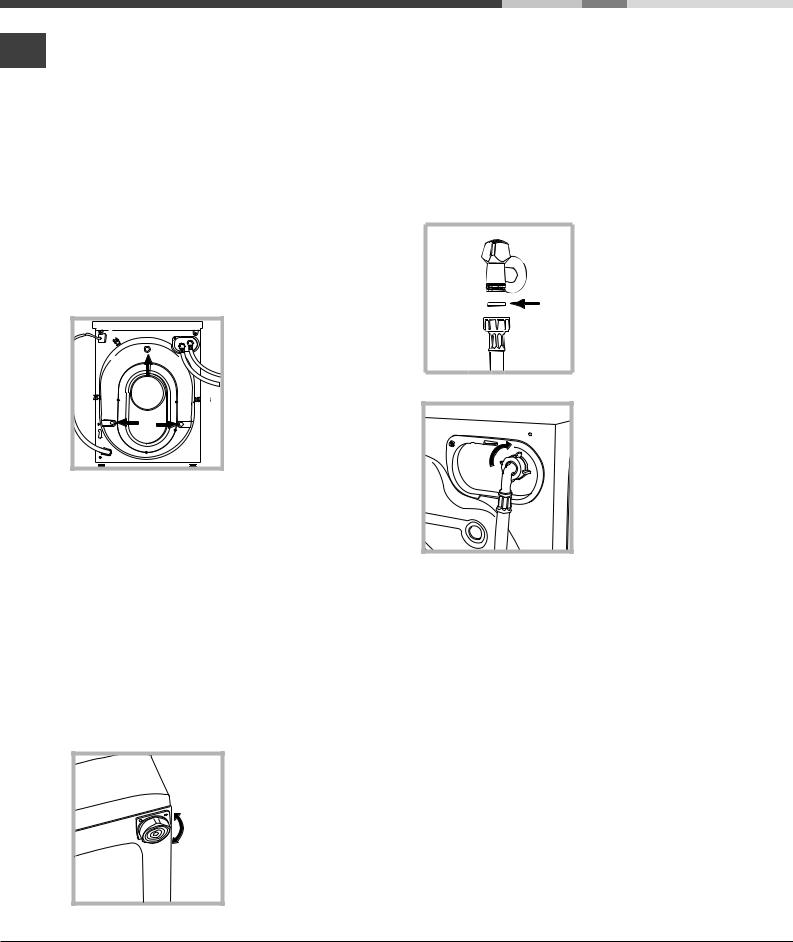
Installation
Keep this instruction manual in a safe place for GB future reference. Should the appliance be sold,
transferred or moved, make sure the instruction manual accompanies the washing machine to inform the new owner as to its operation and features.
Read these instructions carefully: they contain vital information on installation, use and safety.
Unpacking and levelling
Unpacking
1.Unpack the washing machine.
2.Check whether the washing machine has been damaged during transport. If this is the case, do not install it and contact your retailer.
3. Remove the three protective screws and the rubber washer with the respective spacer, situated on the rear of the appliance (see figure).
4.Seal the gaps using the plastic plugs provided.
5.Use the plug provided to seal the three holes where the plug was housed, situated on the lower right-hand side on the rear of your appliance.
6.Keep all the parts: you will need them again if the washing machine needs to be moved to another location.
Packaging materials are not children’s toys.
Levelling
1. Install the washing machine on a flat sturdy floor, without resting it up against walls, furniture cabinets or other.
2. If the floor is not perfectly level, compensate for any unevenness
by tightening or
loosening the adjustable
front feet (see figure); the angle of inclination, measured according to the worktop, must not exceed 2°.
Levelling your appliance correctly will provide it with stability and avoid any vibrations, noise and shifting during operation. If it is placed on a fitted or loose carpet, adjust the feet in such a way as to allow enough room for ventilation beneath the washing machine.
Electric and water connections
Connecting the water inlet hose
1. Insert seal A into the end of the inlet hose and screw the latter onto a cold water tap with 3/4 gas theaded
|
A |
mouth (see figure). |
|
|
Before making the |
||
|
connection, allow the |
||
|
water to run freely until |
||
|
it is perfectly clear. |
||
|
2. Connect the other end |
||
|
of the water inlet hose to |
||
|
the washing machine, |
||
|
screwing it |
onto the |
|
|
appliance’s cold water |
||
|
inlet, situated on the top |
||
|
right-hand side on the |
||
|
rear of the |
appliance |
|
|
(see figure). |
3. Make sure there are no kinks or bends in the hose.
The water pressure at the tap must be within the values indicated in the Technical details table
(on the next page).
If the water inlet hose is not long enough, contact a specialist store or an authorised serviceman.
2
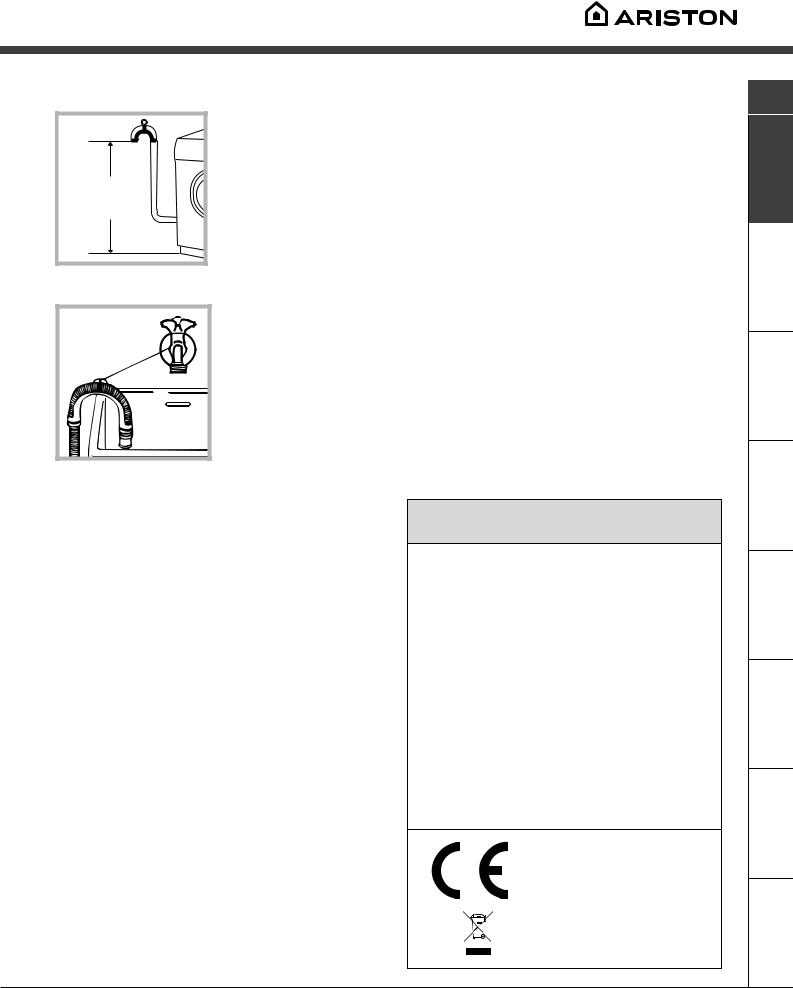
Connecting the drain hose
Connect the drain hose, without bending it, to a draining duct or a wall drain situated between 65 and 100 cm from the floor;
alternatively, place it over the edge of a basin, sink or tub, fastening the duct supplied to the tap (see figure). The free end of the hose should not be underwater.
We advise against the use of hose extensions; in case of absolute need, the extension must have the same diameter as the original hose and must not exceed 150 cm in length.
Electric connection
Before plugging the appliance into the mains socket, make sure that:
•the socket is earthed and in compliance with the applicable law;
•the socket is able to sustain the appliance’s maximum power load indicated in the Technical details table (on the right);
•the supply voltage is included within the values i ndicated on the Technical details table
(on the right);
•the socket is compatible with the washing machine’s plug. If this is not the case, replace the socket or the plug.
The washing machine should not be installed in an outdoor environment, not even when the area is sheltered, because it may be very dangerous to leave it exposed to rain and thunderstorms.
When the washing machine is installed, the mains socket must be within easy reach.
Do not use extensions or multiple sockets.
The power supply cable must never be bent or dangerously compressed.
The power supply cable must only be replaced by an authorised serviceman.
Warning! The company denies all liability if and when these norms are not respected.
The first wash cycle
Once the appliance has been installed, and before you use it for the first time, run a wash cycle with detergent and no laundry, setting the 90°C programme without a pre-wash cycle.
Technical details
|
Model |
AVL 84 |
|
|
59.5 cm wide |
||
|
Dimensions |
85 cm high |
|
|
53.5 cm deep |
||
|
Capacity |
from 1 to 5 kg |
|
|
Electric |
voltage 220/230 Volts 50 Hz |
|
|
connections |
maximum absorbed power 1850 W |
|
|
Water |
maximum pressure 1 MPa (10 bar) |
|
|
minimum pressure 0.05 MPa (0.5 bar) |
||
|
connections |
||
|
drum capacity 46 litres |
||
|
Spin speed |
up to 800 rpm |
|
|
Control |
||
|
programmes |
programme 3; temperature 60°C; |
|
|
according to |
run with a load of 5 kg. |
|
|
IEC456 directive |
This appliance is compliant with the following European Community Directives:
—73/23/CEE of 19/02/73 (Low Voltage) and subsequent amendments
—89/336/CEE of 03/05/89 (Electromagnetic Compatibility) and
subsequent amendments — 2002/96/CE
GB
Precautions Detergents Programmes Description Installation
Service Troubleshooting Care
3
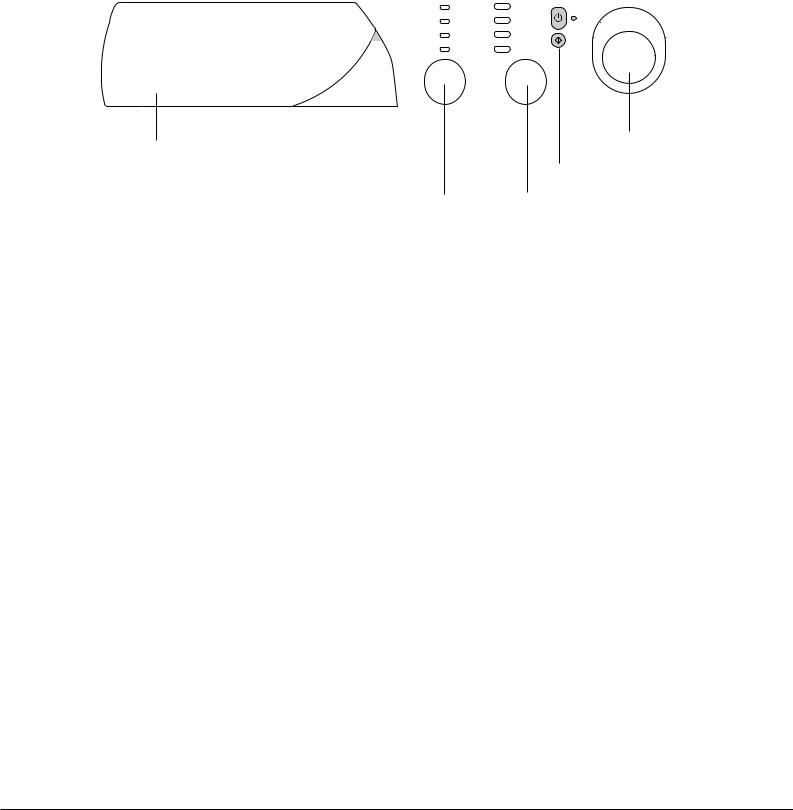
Washing machine description
|
Control panel |
FUNCTION |
|||||||||||
|
GB |
Buttons |
|||||||||||
|
Leds |
START/STOP |
|||||||||||
|
Button |
||||||||||||
|
ON-OFF/DOOR LOCK l |
||||||||||||
|
Programme key |
||||||||||||
|
Led |
||||||||||||
|
Detergent dispenser |
PROGRAMME |
|
|
Knob |
||
|
START/RESET |
||
|
Button |
||
|
TEMPERATURE |
||
|
SPIN SPEED |
Knob |
|
|
Knob |
Detergent dispenser: to add detergent and fabric softener (see page 8).
Programme key: to consult a straightforward chart of the different programmes available: pull the grey tab outwards to open it.
LEDS: to find out which wash cycle phase is under way.
If the Delay Timer function has been set, the time left until the programme starts will be indicated (see page 5).
SPIN SPEED knob: to set the spin speed or exclude the spin cycle completely (see page 7).
FUNCTION buttons: to select the functions available. The button corresponding to the function selected will remain on.
TEMPERATURE knob: to set the temperature or the cold wash cycle (see page 7).
START/STOP button: to turn the washing machine on and off.
START/RESET button: to start the programmes or cancel any incorrect settings.
ON-OFF/DOOR LOCK Led: to find out whether the washing machine is on and if the appliance door can be opened (see page 5).
PROGRAMME knob: to select the wash programmes. The retractable control knob: press the centre of the knob for it to pop out. The knob stays still during the cycle.
4

Leds
The LEDS provide important information. This is what they can tell you:
Delay set:
If the Delay Timer function has been enabled (see page. 7), once you have started the programme, the LED corresponding to the delay set will begin to flash:
As time passes, the remaining delay will be displayed, and the corresponding LED will flash:
Once the set delay is complete, the flashing LED will turn off and the programme set will start.
Cycle phase under way:
During the wash cycle, the LEDs gradually illuminate on to indicate the cycle phase under way:
Prewash
Wash
Rinse
Spin cycle
Note: during draining, the LED corresponding to the Spin cycle phase will be turned on.
Function buttons
The FUNCTION BUTTONS also act like LEDS.
When a function is selected, the corresponding button is illuminated.
If the function selected is incompatible with the programme set, the button will flash and the function will not be enabled.
If you set a function that is incompatible with another function you selected previously, only the last one selected will be enabled.

If this LED is on, the appliance door is locked to prevent it from being opened accidentally; to avoid any damages, wait for the LED to flash before you open the appliance door.
The rapid flashing of the ON-OFF/DOOR LOCK Led together with the flashing of at least one other LED indicates there is an abnormality. Call for Technical Assistance.
GB
Precautions Detergents Programmes Description Installation
Service Troubleshooting Care
5

Starting and Programmes
Briefly: starting a programme
GB
|
1. |
Switch the washing machine on by pressing button . |
|
All the LEDS will light up for a few seconds and |
|
|
the ON-OFF/DOOR LOCK Led will begin to flash. |
|
|
2. |
Load your laundry into the washing machine and |
|
shut the appliance door. |
|
|
3. |
Set the PROGRAMME knob to the programme |
|
required. |
|
|
4. |
Set the wash temperature (see page 7). |
Programme table
5.Set the spin speed (see page 7).
6.Add the detergent and any fabric softener (see page 8).
7.Start he programme by pressing the START/RESET button. To cancel it, keep the START/RESET button pressed for at least 2 seconds.
8.When the programme is finished, the ON-OFF/ DOOR LOCK Led will flash to indicate that the appliance door can be opened. Take out your laundry and leave the appliance door ajar to allow
the drum to dry thoroughly. Turn the washing machine off by pressing button 
|
Type of fabric and degree of |
Wash |
Detergent |
Fabric |
Cycle |
|||||
|
Programmes |
length |
Description of wash cycle |
|||||||
|
soil |
temperat. |
Pre- |
Wash |
softener |
(minutes) |
||||
|
wash |
|||||||||
|
Cotton |
|||||||||
|
Extremely soiled whites |
1 |
90°C |
• |
• |
• |
137 |
Pre-wash, wash cycle, rinse cycles, |
||
|
(sheets, tablecloths, etc.) |
intermediate and final spin cycles |
||||||||
|
Extremely soiled whites |
2 |
90°C |
• |
• |
120 |
Wash cycle, rinse cycles, intermediate |
|||
|
(sheets, tablecloths, etc.) |
and final spin cycles |
||||||||
|
Heavily soiled whites and |
3 |
60°C |
• |
• |
105 |
Wash cycle, rinse cycles, intermediate |
|||
|
fast colours |
and final spin cycles |
||||||||
|
Heavily soiled whites and |
4 |
40°C |
• |
• |
72 |
Wash cycle, rinse cycles, intermediate |
|||
|
fast colours |
and final spin cycles |
||||||||
|
Slightly soiled whites and |
Wash cycle, rinse cycles, intermediate |
||||||||
|
delicate colours (shirts, |
5 |
30°C |
• |
• |
65 |
||||
|
and final spin cycles |
|||||||||
|
jumpers, etc.) |
|||||||||
|
Synthetics |
|||||||||
|
Heavily soiled fast colours |
6 |
60°C |
• |
• |
77 |
Wash cycle, rinse cycles, anti-crease |
|||
|
(baby linen, etc.) |
or delicate spin cycle |
||||||||
|
Fast colours (all types of |
6 |
40°C |
• |
• |
62 |
Wash cycle, rinse cycles, anti-crease |
|||
|
slightly soiled garments) |
or delicate spin cycle |
||||||||
|
Heavily soiled fast colours |
7 |
50°C |
• |
• |
73 |
Wash cycle, rinse cycles, anti-crease |
|||
|
(baby linen, etc.) |
or delicate spin cycle |
||||||||
|
Delicate colours (all types of |
8 |
40°C |
• |
• |
58 |
Wash cycle, rinse cycles, anti-crease |
|||
|
slightly soiled garments) |
or delicate spin cycle |
||||||||
|
Delicate colours (all types of |
9 |
30°C |
• |
• |
30 |
Wash cycle, rinse cycles and delicate |
|||
|
slightly soiled garments) |
spin cycl |
||||||||
|
Delicate |
|||||||||
|
Wool |
10 |
40°C |
• |
• |
50 |
Wash cycle, rinse cycles and delicate |
|||
|
spin cycle |
|||||||||
|
Very delicate fabrics |
11 |
30°C |
• |
• |
45 |
Wash cycle, rinse cycles, anti-crease |
|||
|
(curtains, silk, viscose, etc.) |
or draining cycle |
||||||||
|
PARTIAL PROGRAMMES |
|||||||||
|
Rinse |
• |
Rinse cycles and spin cycle |
|||||||
|
Delicate rinse cycle |
• |
Rinse cycles, anti-crease or draining |
|||||||
|
Spin cycle |
Draining and heavy duty spin cycle |
||||||||
|
Delicate spin cycle |
Draining and delicate spin cycle |
||||||||
|
Draining |
Draining |
||||||||
Notes
For the anti-crease function: see Easy iron, opposite page. The information contained in the table is purely indicative.
Special programmes
Daily 30′ (programme 9 for Synthetics) is designed to wash lightly soiled garments in a short amount of time: it only lasts 30 minutes and allows you to save on both time and energy. By setting this programme (9 at 30°C), you can wash different fabrics together (except for woollen and silk items), with a maximum load of 3 kg.
We recommend the use of liquid detergent.
6
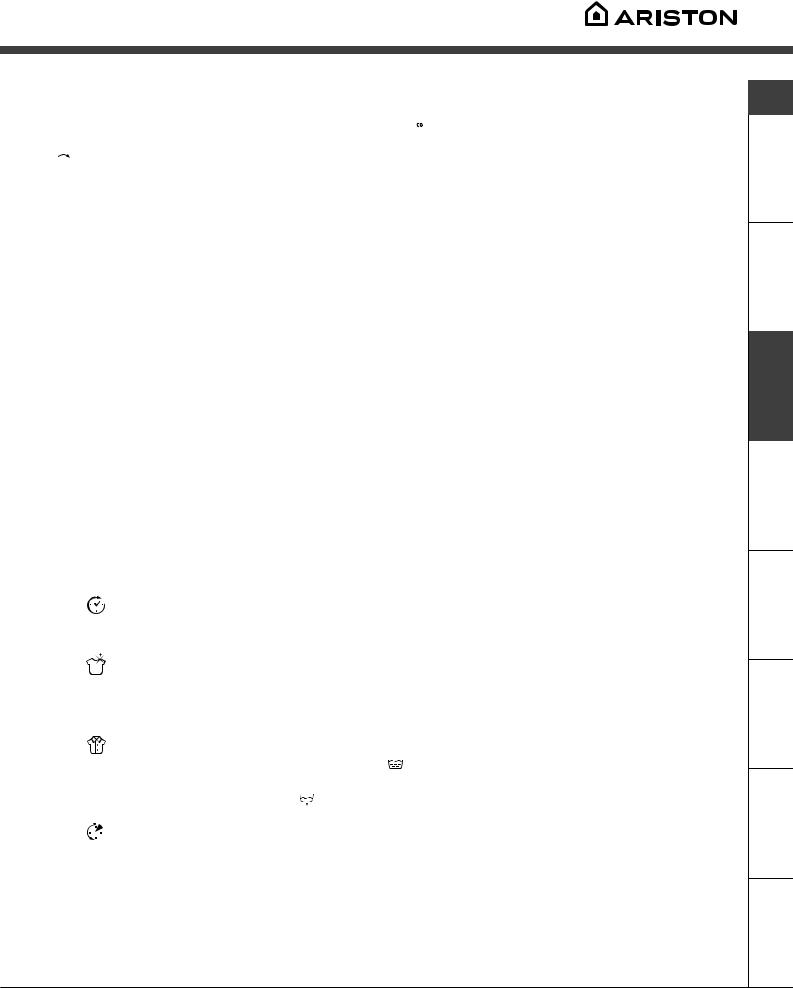
Personalisations

Turn the TEMPERATURE knob to set the wash temperature (see Programme table on page 6). The temperature can be lowered, or even set to a cold wash (

Turn the SPIN SPEED knob to set the spin speed for the programme selected.
The maximum spin speeds for each programme are as follows:
|
Programmes |
Maximum spin speed |
|
Cottone |
800 rpm |
|
Synthetics |
800 rpm |
|
Wool |
600 rpm |
|
Silk |
no |
The spin speed can be lowered, or the spin cycle can be excluded altogether by selecting symbol 
The washing machine will automatically prevent you from selecting a spin speed higher than the maximum speed for each programme.
Functions
To enable a function:
1.press the button corresponding to the desired function, according to the table below;
2.the function is enabled when the corresponding button is illuminated.
Note: The rapid flashing of the button indicates that the corresponding function cannot be selected for the programme set.
|
Function |
Effect |
Comments |
Enabled with |
||||
|
programmes: |
|||||||
|
Press the button repeatedly until the LED corresponding to the |
|||||||
|
Delays the start |
desired delay is turned on. |
All |
|||||
|
of the wash by |
The fifth time the button is pressed, the function will be disabled. |
||||||
|
up to 9 hours. |
N.B.: Once you have pressed the Start/Reset button, the delay |
||||||
|
Delay Timer |
can only be decreased if you wish to modify it. |
||||||
|
Allows for an |
|||||||
|
Super |
impeccable wash, |
1, 2, 3, 5, |
|||||
|
visibly whiter |
This function is incompatible with the RAPID function. |
||||||
|
Wash |
6, 7, 8. |
||||||
|
than a standard |
|||||||
|
Class A wash. |
|||||||
|
This option |
When this function is set, programmes 6, 7, 8, 11 and Delicate |
All |
|||||
|
reduces the |
|||||||
|
rinse will end with the laundry left to soak (Anti-crease) and the |
|||||||
|
amount of |
programmes |
||||||
|
Rinse cycle phase LED |
will flash. |
||||||
|
Easy iron |
creasing on |
except for |
|||||
|
— to conclude the cycle, press the START/RESET button; |
|||||||
|
fabrics, making |
1, 2, 4, 9, 10 |
||||||
|
— to run the draining cycle alone, set the knob to the relative |
|||||||
|
them easier to |
and Draining. |
||||||
|
symbol |
and press the START/RESET button. |
||||||
|
iron. |
|||||||
|
Cuts the duration |
1, 2, 3, 5, |
||||||
|
of the wash cycle |
This function is incompatible with the SUPER WASH function. |
||||||
|
6, 7, 8 |
|||||||
|
Rapid |
by 30%. |
||||||
GB
Precautions Detergents Programmes Description Installation
Service Troubleshooting Care
7
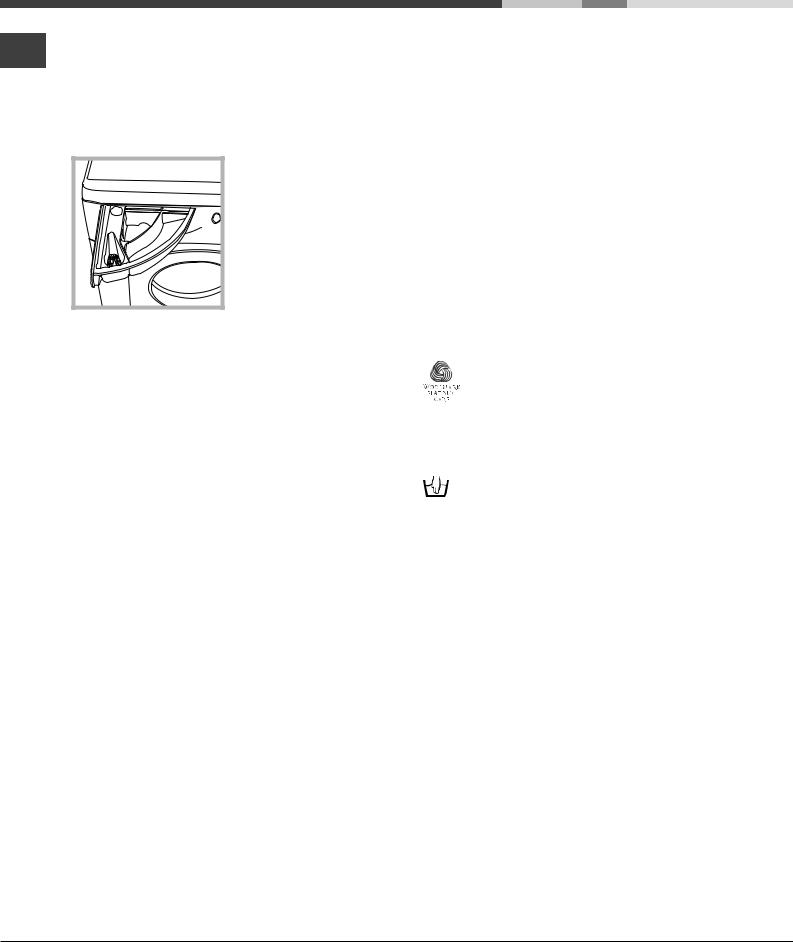
Detergents and laundry
Detergent dispenser
GB
Good washing results also depend on the correct dose of detergent: adding too much detergent won’t necessarily make for a more efficient wash, and may in fact cause build up on the interior of your appliance and even pollute the environment.
Open up the detergent dispenser and pour in the detergent and fabric softener, as follows.
compartment 1: Detergent for pre-wash (powder)
compartment 2: Detergent for the wash cycle (powder or liquid)
Liquid detergent should only be poured in immediately prior to the wash cycle start. compartment 3: Additives (fabric softeners, etc.)
The fabric softener should not overflow from the grid.
Do not use hand wash detergent because it may form too much foam.
Special items
Curtains: fold curtains and place them in a pillow case or mesh bag. Wash them separately without exceeding half the appliance load. Use programme 11 which excludes the spin cycle automatically.
Quilted coats and windbreakers: if they are padded with goose or duck down, they can be machine-washed. Turn the garments inside out and load a maximum of 2-3 kg, repeating the rinse cycle once or twice and using the delicate spin cycle. Trainers: remove any mud. They can be washed together with jeans and other tough garments, but not with whites.
Wool: for best results, use a specific detergent, taking care not to exceed a load of 1 kg.
Cashmere Platinum
As gentle as a hand wash.
Ariston sets a new standard of superior performance that has been endorsed by
The Woolmark Company with the prestigious Woolmark Platinum Care brand.
Look for the Woolmark Platinum Care logo on the washing machine to ensure you can safely and effectively wash wool garments labelled as «hand
wash» (M.00221):
Set programme 10 for all «Hand wash» garments, using the appropriate detergent.
Preparing your laundry
•Divide your laundry according to:
—the type of fabric/the symbol on the label.
—the colours: separate coloured garments from whites.
•Empty all pockets and check for loose buttons.
•Do not exceed the weight limits stated below, which refer to the weight when dry:
Sturdy fabrics: max 5 kg Synthetic fabrics: max 2.5 kg Delicate fabrics: max 2 kg Wool: max 1 kg
How much does your laundry weigh?
1sheet 400-500 g
1pillow case 150-200 g
1tablecloth 400-500 g
1bathrobe 900-1,200 g
1towel 150-250 g
8
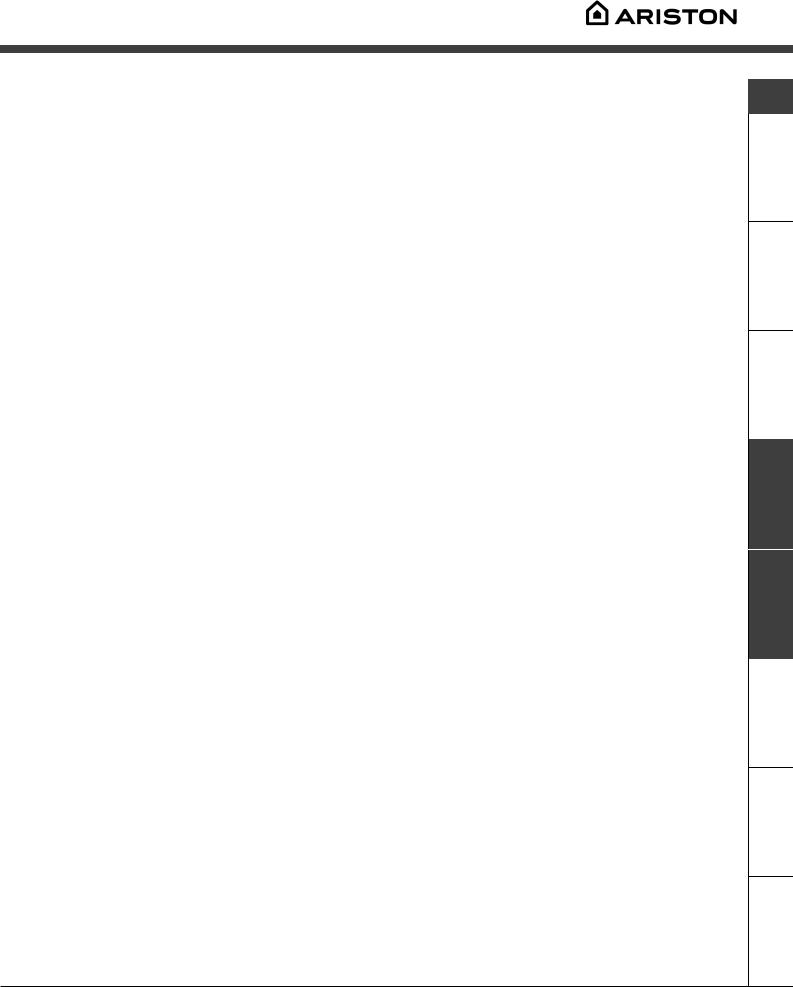
Precautions and advice
The washing machine was designed and built in compliance with the applicable international safety regulations. The following information is provided for your safety and should consequently be read carefully.
General safety
•This appliance has been designed for nonprofessional, household use and its functions must not be changed.
•This washing machine should only be used by adults and in accordance with the instructions provided in this manual.
•Never touch the washing machine when barefoot or with wet or damp hands or feet.
•Do not pull on the power supply cable to unplug the appliance from the electricity socket. Pull the plug out yourself.
•Do not open the detergent dispenser while the appliance is in operation.
•Do not touch the drain water as it could reach very high temperatures.
•Never force the washing machine door: this could damage the safety lock mechanism designed to prevent any accidental openings.
•In the event of a malfunction, do not under any circumstances touch internal parts in order to attempt repairs.
•Always keep children well away from the appliance while in operation.
•The appliance door tends to get quite hot during the wash cycle.
•Should it have to be moved, proceed with the help of two or three people and handle it with the utmost care. Never try to do this alone, because the appliance is very heavy.
•Before loading your laundry into the washing machine, make sure the drum is empty.
Disposal
• Disposal of old electrical appliances
The European Directive 2002/96/EC on Waste Electrical and Electronic Equipment (WEEE), requires that old household electrical appliances must not be disposed of in the normal unsorted municipal waste stream. Old appliances must be collected separately in order to optimise the recovery and recycling of the materials they contain and reduce the impact on human health and the environment.
The crossed out «wheeled bin» symbol on the product reminds you of your obligation, that when you dispose of the appliance it must be separately collected.
Consumers should contact their local authority or retailer for information concerning the correct disposal of their old appliance.
•Disposing of an old washing machine:
before scrapping your appliance, cut the power supply cable and remove the appliance door.
Saving energy and respecting the environment
Environmentally-friendly technology
If you only see a little water through your appliance door, this is because thanks to the latest technology, your washing machine only needs less than half the amount of water to get the best results: an objective reached to respect the environment.
Saving on detergent, water, energy and time
•To avoid wasting resources, the washing machine should be used with a full load. A full load instead of two half loads allows you to save up to 50% on energy.
•The pre-wash cycle is only necessary on extremely soiled garments. Avoiding it will save on detergent, time, water and between 5 and 15% energy.
•Treating stains with a stain remover or leaving them to soak before washing will cut down the need to wash them at high temperatures. A programme at 60°C instead of 90°C or one at 40°C instead of 60°C will save up to 50% on energy.
•Use the correct quantity of detergent depending on the water hardness, how soiled the garments are and the amount of laundry you have, to avoid wastage and to protect the environment: despite being biodegradable, detergents do contain ingredients that alter the natural balance of the environment. In addition, avoid using fabric softener as much as possible.
•If you use your washing machine from late in the afternoon until the early hours of the morning, you will help reduce the electricity board’s peak load. The Delay Timer option (see page 7) helps to organise your wash cycles accordingly.
•If your laundry has to be dried in a tumble dryer, select a high spin speed. Having the least water possible in your laundry will save you time and energy in the drying process.
GB
Precautions Detergents Programmes Description Installation
Service Troubleshooting Care
9
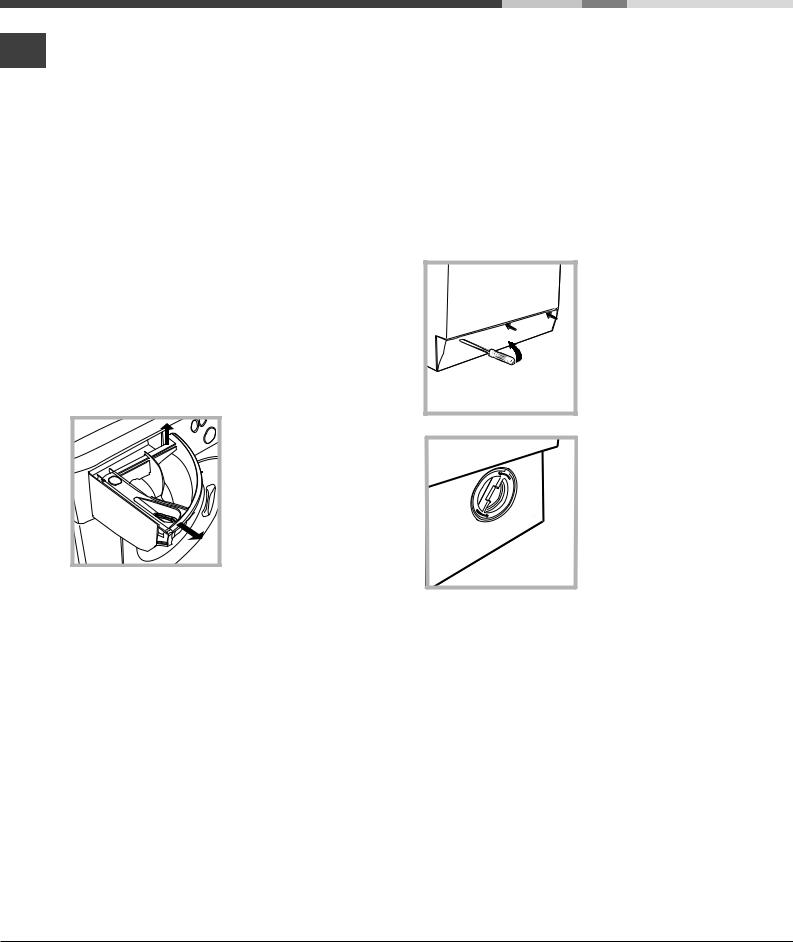
Care and maintenance
GB
Cutting off the water or electricity supply
•Turn off the water tap after every wash. This will limit the wear of your appliance’s water system and also prevent leaks.
•Unplug your appliance when cleaning it and during all maintenance operations.
Cleaning your appliance
The exterior and rubber parts of your appliance can be cleaned with a soft cloth soaked in lukewarm soapy water. Do not use solvents or abrasives.
Cleaning the detergent dispenser
Remove the dispenser by raising it and pulling it out (see figure).
Wash it under running water; this operation should be repeated frequently.
Cleaning the pump
The washing machine is fitted with a self-cleaning pump that does not require any maintenance. Sometimes, small items (such as coins or buttons) may fall into the pre-chamber that protects the pump, situated in the lower part of the same.
Make sure the wash cycle has ended and unplug the appliance.
To access the pre-chamber:
1. using a screwdriver, remove the cover panel on the lower front of the washing machine (see figure);
2. unscrew the lid rotating it anticlockwise (see figure): a little water may trickle out. This is perfectly normal;
Caring for your appliance door and drum
•Always leave the appliance door ajar to prevent unpleasant odours from forming.
3.clean the interior thoroughly;
4.screw the lid back on;
5.reposition the panel, making sure the hooks are securely in place before you push it onto the appliance.
Checking the water inlet hose
Check the water inlet hose at least once a year. If you see any cracks, replace it immediately: during the wash cycles, water pressure is very strong and a cracked hose could easily split open.
Never use hoses that have already been used.
10
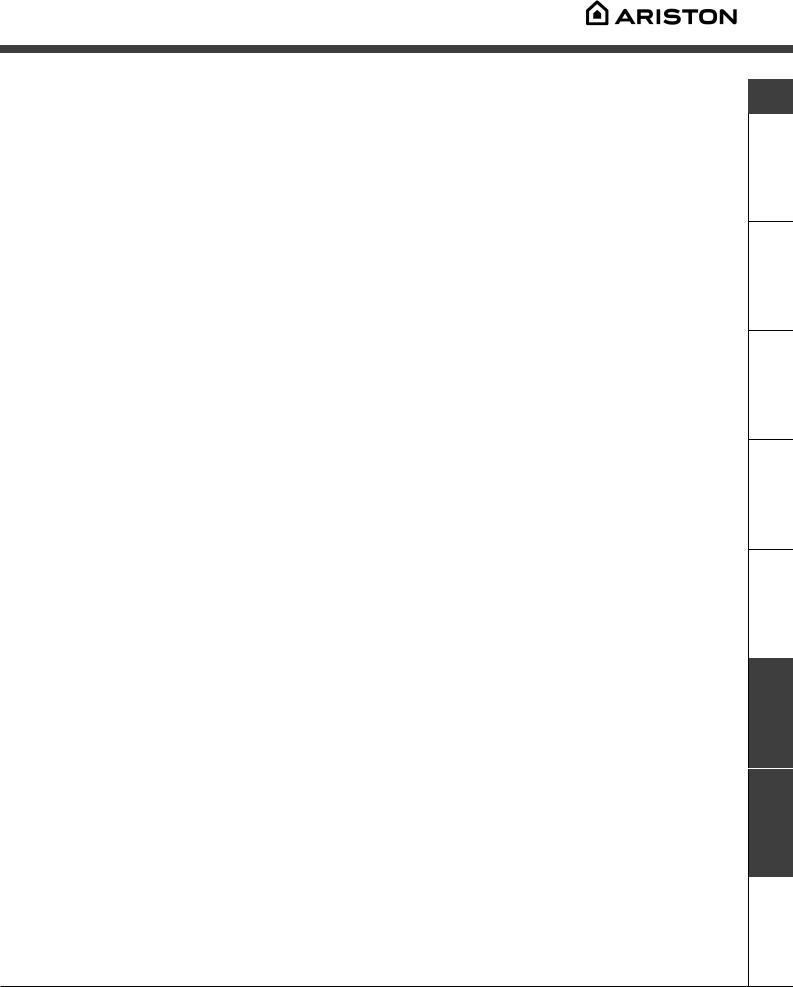
Troubleshooting
Your washing machine could fail to work. Before calling for Assistance (see page 12), make sure the problem can’t easily be solved by consulting the following list.
Problem
The washing machine won’t start.
The wash cycle won’t start.
Possible causes/Solution:
•The appliance is not plugged into the socket, or not enough to make contact.
•There has been a power failure.
•The appliance door is not shut properly.
•The 
•The START/RESET button has not been pressed.
•The water tap is not turned on.
•A delayed start has been set (using the Delay Timer, see page 7).
|
The washing machine fails to |
• |
The water inlet hose is not connected to the tap. |
|
load water. |
• |
The hose is bent. |
|
• |
The water tap is not turned on. |
|
|
• |
There is a water shortage. |
|
|
• |
The water pressure is insufficient. |
|
|
• |
The START/RESET button has not been pressed. |
The washing machine continuously loads and unloads water.
•The drain hose is not fitted between 65 and 100 cm from the floor
(see page 3).
•The free end of the hose is underwater (see page 3).
•The wall drainage system doesn’t have a breather pipe.
If the problem persists even after these checks, turn off the water tap, switch the appliance off and call for Assistance. If the dwelling is on one of the upper floors of a building, there may be drain trap problems causing the washing machine to load and unload water continuously. In order to avoid such an inconvenience, special anti-drain trap valves are available in shops.
|
The washing machine does not |
• |
The programme does not foresee the draining: some programmes |
|
drain or spin. |
require enabling the draining manually (see page 6). |
|
|
• |
The Easy iron option is enabled: to complete the programme, press |
|
|
the START/RESET button (see page 7). |
||
|
• |
The drain hose is bent (see page 3). |
|
|
• |
The drain duct is clogged. |
The washing machine vibrates too much during the spin cycle.
The washing machine leaks.
•The drum was not unblocked correctly during installation (see page 2).
•The washing machine is not level (see page 2).
•The washing machine is closed in between furniture cabinets and the wall (see page 2).
•The water inlet hose is not screwed on correctly (see page 2).
•The detergent dispenser is obstructed (to clean it, see page 10).
•The drain hose is not secured properly (see page 2).
The ON-OFF/DOOR LOCK Led flashes rapidly at the same time as at least one other LED:
There is too much foam.
•Call for Assistance because this means there is an abnormality.
•The detergent is not suitable for machine washing (it should bear the definition «for washing machines» or «hand and machine wash», or the like).
•You used too much detergent.
GB
Precautions Detergents Programmes Description Installation
Service Troubleshooting Care
11

Service
Before calling for Assistance:
|
GB |
• |
Check whether you can solve the problem on your own (see page 11); |
|
• |
Restart the programme to check whether the problem has been solved; |
|
|
• |
If this is not the case, contact an authorised Technical Service Centre on the telephone number |
|
|
provided on the guarantee certificate. |
||
|
Always request the assistance of authorised servicemen. |
Notify the operator of:
•the type of problem;
•the appliance model (Mod.);
•the serial number (S/N);
This information can be found on the data plate situated on the rear of the washing machine.
Service
12

Bedienungsanleitungen
|
WASCHVOLLAUTOMAT |
||||||
|
INHALTSVERZEICHNIS |
||||||
|
DE |
||||||
|
Installation, 14-15 |
||||||
|
DE |
||||||
|
Auspacken und Aufstellen, 14 |
||||||
|
Wasserund Elektroanschlüsse, 14-15 |
||||||
|
Deutsch |
Erster Waschgang, 15 |
|||||
|
Technische Daten, 15 |
||||||
|
Beschreibung des |
||||||
|
Waschvollautomaten, 16-17 |
||||||
|
Schalterblende, 16 |
||||||
|
Kontrollleuchten, 17 |
||||||
|
Inbetriebnahme und Programme, 18 |
||||||
|
Kurz zusammengefasst: Waschprogramm starten, 18 |
||||||
|
Programmtabelle, 18 |
||||||
|
Individualisierungen, 19 |
||||||
|
AVL 84 |
Einstellen der Temperatur, 19 |
|||||
|
Einstellen der Schleuder, 19 |
||||||
|
Funktionen, 19 |
||||||
|
Waschmittel und Wäsche, 20 |
||||||
|
Waschmittelschublade, 20 |
||||||
|
Vorsortieren der Wäsche, 20 |
||||||
|
Besondere Wäscheteile, 20 |
||||||
|
Cachemire Platinum, 20 |
||||||
|
Vorsichtsmaßregeln und Hinweise, 21 |
||||||
|
Allgemeine Sicherheit, 21 |
||||||
|
Entsorgung, 21 |
||||||
|
Energie sparen und Umwelt schonen, 21 |
||||||
|
Reinigung und Pflege, 22 |
||||||
|
Wasserund Stromversorgung abstellen, 22 |
||||||
|
Reinigung des Gerätes, 22 |
||||||
|
Reinigung der Waschmittelschublade, 22 |
||||||
|
Pflege der Gerätetür und Trommel, 22 |
||||||
|
Reinigung der Pumpe, 22 |
||||||
|
Kontrolle des Wasserzulaufschlauchs, 22 |
||||||
|
Störungen und Abhilfe, 23 |
||||||
|
Kundendienst, 24 |
||||||
|
Bevor Sie sich an den Kundendienst wenden, 24 |
||||||
13
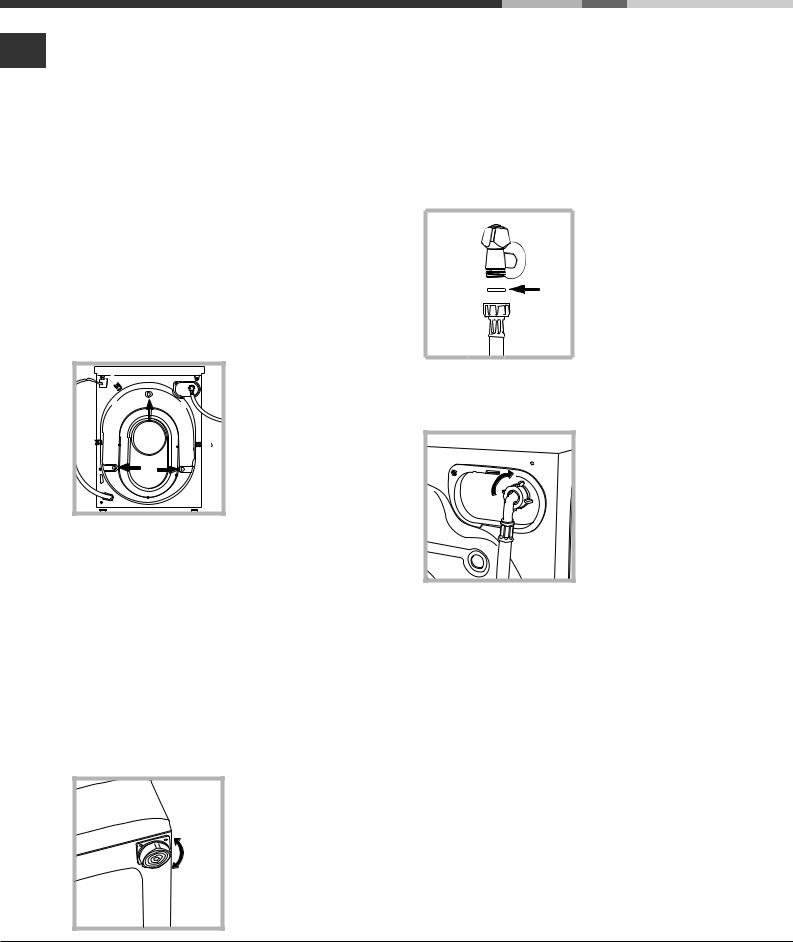
Installation
Es ist äußerst wichtig, diese Bedienungsanleitung
DE sorgfältig aufzubewahren, um sie jederzeit zu Rate ziehen zu können. Sorgen Sie dafür, dass sie im Falle eines Umzugs oder Übergabe an einen anderen Benutzer das Gerät stets begleitet, damit auch der neue Inhaber die Möglichkeit hat, diese zu Rate zu ziehen.
Lesen Sie bitte folgende Hinweise aufmerksam durch, sie liefern wichtige Informationen hinsichtlich der Installation, dem Gebrauch und der Sicherheit.
Auspacken und Aufstellen
Auspacken
1.Gerät auspacken.
2.Sicherstellen, dass der Waschvollautomat keine Transportschäden erlitten hat. Im Falle einer Beschädigung Gerät bitte nicht anschließen, sondern den Kundendienst anfordern.
3. Die drei Transportschutzschrauben ausschrauben und das an der Rückwand befindliche Gummiteil nebst entsprechendem Distanzstück abnehmen (siehe Abbildung).
4.Die Löcher mittels der mitgelieferten Kunststoffstöpsel schließen.
5.Die drei Löcher, die zur Lagerung des Steckers verwendet worden sind (an der Rückwand unten rechts), durch den entsprechenden Stöpsel schließen.
6.Sämtliche Teile aufbewahren: Sollte der Waschvollautomat erneut transportiert werden müssen, müssen diese Teile wieder eingesetzt werden.
Verpackungsmaterial ist kein Spielzeug für Kinder
Standfläche
1. Der Waschvollautomat muss auf einem ebenen, festen Untergrund aufgestellt werden, ohne ihn an Wände, Möbelteile oder ähnliches anzulehnen.
2. Sollte der Boden nicht perfekt eben sein, müssen die Unebenheiten durch
Anbzw. Ausdrehen der
vorderen Stellfüße ausge-
glichen werden (siehe Abbildung), der auf der Arbeitsfläche zu ermittelnde Neigungsgrad darf 2° nicht überschreiten.
Eine präzise Nivellierung verleiht dem Gerät die erforderliche Stabilität, durch die Vibrationen, Betriebsgeräusche und ein Verrücken des Gerätes vermieden werden. Bei Teppichböden müssen die Stellfüße so reguliert werden, dass ein ausreichender Freiraum zur Belüftung unter dem Waschvollautomaten gewährleistet ist.
Wasserund Elektroanschlüsse
Anschluss des Zulaufschlauches
|
1. Legen Sie die Gummi- |
||
|
dichtung A in das |
||
|
Anschlussstück des |
||
|
Zulaufschlauches ein und |
||
|
A |
drehen Sie dieses an |
|
|
einen mit |
||
|
Gewindeanschluss von ¾ |
||
|
G versehenen Kaltwasser- |
||
|
hahn (siehe Abbildung). |
||
|
Lassen Sie das Wasser |
||
|
vor dem Anschluss so lange auslaufen, bis klares |
||
|
Wasser austritt. |
||
|
2. Schließen Sie das |
||
|
andere Ende des Schlau- |
||
|
ches an den oben rechts |
||
|
am Rückteil des Wasch- |
||
|
vollautomaten befindli- |
||
|
chen Wasseranschluss |
||
|
an (siehe Abbildung). |
3. Der Schlauch darf hierbei nicht eingeklemmt oder abgeknickt werden.
Der Wasserdruck muss innerhalb der Werte liegen, die in der Tabelle der Technischen Daten angegebenen sind (siehe nebenstehende Seite).
Sollte der Zulaufschlauch nicht lang genug sein, dann wenden Sie sich bitte an einen Fachhändler oder an einen autorisierten Fachmann.
14
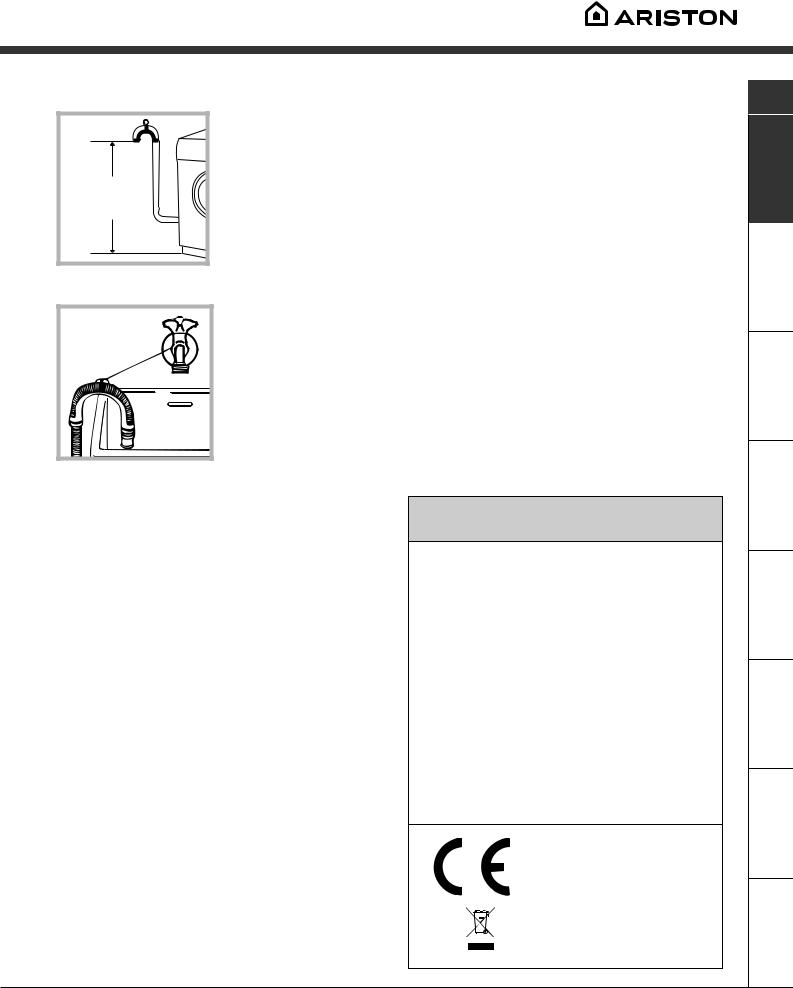
Anschluss des Ablaufschlauches
Schließen Sie den Ablaufschlauch, ohne ihn dabei zu krümmen, an eine Ablaufleitung, oder an einen in der Wand in einer Mindesthöhe von 65 — 100 cm angelegten Ablauf an;
oder hängen Sie ihn in ein Becken oder eine Wanne ein; befestigen Sie ihn in diesem Falle mittels der mitgelieferten Führung an dem Wasserhahn (siehe Abbildung). Das freie Ablaufschlauchende darf nicht unter Wasser bleiben.
Verlängerungsschläuche sollten nicht eingesetzt werden, sollte dies jedoch absolut unvermeidlich sein, muss die Verlängerung denselben Durchmesser des Originalschlauchs aufweisen und 150 cm nicht überschreiten.
Elektronschluss
Vor Einfügen des Steckers in die Steckdose ist sicherzustellen, dass:
•die Steckdose über eine normgerechte Erdung verfügt;
•die Steckdose die in nebenstehender Datentabelle angegebene Höchstlast des Gerätes trägt;
•die Stromspannung den in nebenstehender Datentabelle aufgeführten Werten entspricht;
•der Stecker in die Steckdose passt. Andernfalls muss der Stecker (oder die Steckdose) ersetzt werden.
Der Waschvollautomat darf nicht im Freien installiert werden, auch nicht, wenn es sich um einen geschützten Platz handelt. Es ist gefährlich, Ihren Vollwaschautomaten Gewittern und Unwettern auszusetzen.
Die Steckdose sollte nach installiertem Gerät leicht zugänglich sein.
Verwenden Sie bitte keine Verlängerungen oder Mehrfachstecker.
Das Kabel darf nicht gebogen bzw. eingeklemmt werden.
Das Versorgungskabel darf nur durch autorisierte Fachkräfte ausgetauscht werden.
Achtung! Der Hersteller weist jede Haftung zurück, falls diese Vorschriften nicht eingehalten werden sollten.
Erster Waschgang
Lassen Sie nach der Installation bzw. vor erstmaligem Gebrauch erst einen Waschgang (mit Waschmittel) ohne Wäsche durchlaufen. Stellen Sie hierzu das 90°C- Waschprogramm ohne Vorwäsche ein.
Technische Daten
|
Modell |
AVL 84 |
|
|
Breite 59,5 cm |
||
|
Abmessungen |
Höhe 85 cm |
|
|
Tiefe 53,5 cm |
||
|
Fassungsvermögen |
1 bis 5 kg |
|
|
Elektroanschlüsse |
Spannung 220/230 Volt 50 Hz |
|
|
max. Leistungsaufnahme 1850 W |
||
|
Höchstdruck 1 MPa (10 bar) |
||
|
Wasseranschlüsse |
Mindestdruck 0,05 MPa (0,5 bar) |
|
|
Trommelvolumen 46 Liter |
||
|
Schleudertouren |
bis zu 800 U/min. |
|
|
Prüfprogramme |
Programm 3; Temperatur 60°C; |
|
|
gemäß IEC456 |
bei einer Lademenge von 5 kg. |
Dieses Gerät entspricht den folgenden EG-Richtlinien:
—73/23/EWG vom 19.02.73 (Niederspannung)
und nachfolgenden Änderungen
—89/336/EWG vom 03.05.89 (elektromagnetische Verträglichkeit)
und nachfolgenden Änderungen — 2002/96/CE
DE
und Wartung
Kundendienst Störungen Pflege Vorsichtsmaßregeln Waschmittel Waschprogramme Beschreibung Installation
15
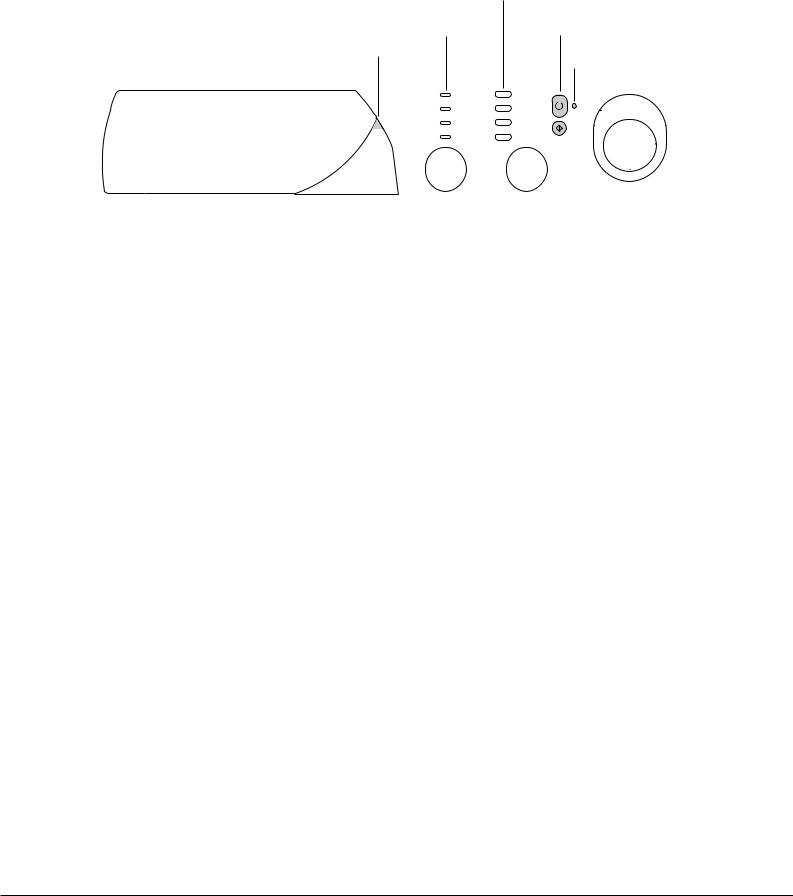
Beschreibung des
Waschvollautomaten
|
Schalterblende |
Taste |
|||
|
DE |
FUNKTIONEN |
|||
|
Kontrollleuchten |
Taste |
|||
|
EIN/AUS |
||||
|
Kontrollleuchte |
||||
|
Anzeigetafel |
ON/FÜLLFENSTER |
|||
|
GESPERRT |
|
Wahlschalter |
|||||||
|
Waschmittelschublade |
PROGRAMME |
||||||
|
Taste |
|||||||
|
START/RESET |
|||||||
|
Wahlschalter |
|||||||
|
Wahlschalter |
TEMPERATUR |
||||||
|
SCHLEUDER |
Waschmittelschublade: für Waschmittel und Zusätze (siehe Seite 20).
Anzeigetafel: die zu jeder Zeit einen klaren Überblick über die möglichen Programme gewährleistet. Ganz einfach an der grauen Zunge herausziehen.
Kontrollleuchten: Zur Kontrolle des Waschprogrammablaufs.
Wurde die Funktion Delay Timer eingestellt, wird die bis zum Start noch verbleibende Zeit
Angezeigt (siehe Seite 17).
Wahlschalter SCHLEUDER: Zur Einstellung oder zum völligen Ausschalten der Schleuder (siehe Seite 19).
Tasten FUNKTIONEN: Zur Einstellung der verfügbaren Funktionen. Die gewählte Einstellung der entsprechenden Funktionstaste bleibt eingeschaltet. (sie leuchtet.
Wahlschalter TEMPERATUR: Zur Einstellung der Waschtemperatur oder der Kaltwäsche (siehe Seite 19).
Taste «EIN/AUS»: zur Einund Ausschaltung des Waschvollautomaten
Taste «START/RESET»: um die Programme zu starten bzw. zu löschen, falls unkorrekt eingestellt.
Kontrollleuchte ON/FÜLLFENSTER GESPERRT: Um Erkennen zu können, ob die Maschine eingeschaltet ist und demnach das Füllfenster nicht geöffnet werden kann (siehe Seite 17).
Wahlschalter PROGRAMME: zur Programmwahl Die Wahlschalter sind flächenbündig angebracht: Durch leichten Druck auf die Knopfmitte können Sie herausgezogen werden. Während des Programmablaufs bleibt der Schalter feststehend.
16
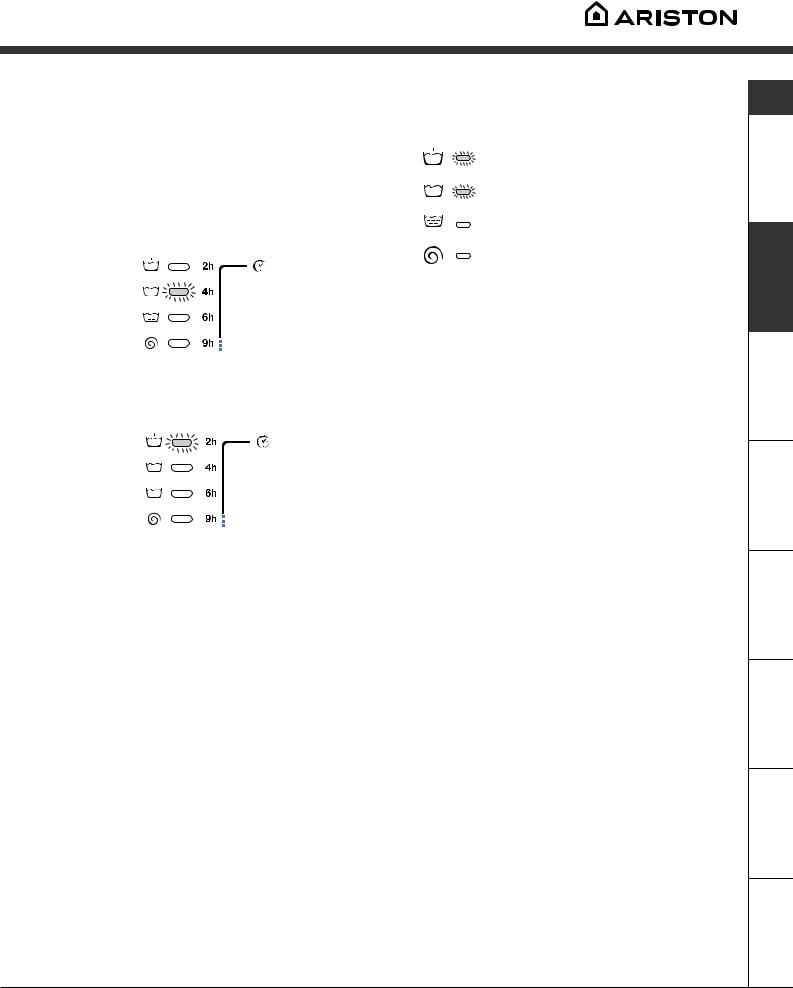
Kontrollleuchten
Die Kontrollleuchten liefern wichtige Hinweise. Sie signalisieren:
Startvorwahl erfolgt:
Wurde die Startvorwahl-Funktion Delay Timer (siehe Seite 19) aktiviert, und das Programm in Gang gesetzt, schaltet die Kontrollleuchte, die der eingestellten Zeitverschiebeung entspricht, auf Blinklicht:
Nach und nach wird die bis zum effektiven Start noch verbleibende Zeit eingeblendet, die entsprechende Kontrollleuchte blinkt:
Nach Ablauf der vorgewählten Zeit erlischt die Kontrollleuchte und das gewählte Waschprogramm startet.
Laufende Programmphase:
Während des Waschprogrammablaufs leuchten die Kontrollleuchten nach und nach auf und zeigen so den jeweiligen Stand an.
Vorwäsche
Hauptwäsche
Spülen
Schleudern
Anmerkung: Während des Abpumpens leuchtet die entsprechende Kontrollleuchte für die Schleuder auf.
Tasten FUNKTIONEN
Die Funktionstasten fungieren auch als Kontrollleuchten. Bei Wahl einer Funktion leuchtet die entsprechende Taste auf.
Ist die gewählte Funktion nicht vereinbar mit dem eingestellten Programm, schaltet die Taste auf Blinklicht und die Funktion wird nicht aktiviert.
Wird eine Funktion eingestellt, die zu der bereits eingestellten nicht zugeschaltet werden kann, bleibt nur die zuletzt gewählte aktiv.

Ist diese Kontrollleuchte eingeschaltet, bedeutet dies, dass das Füllfenster gesperrt ist. Um ungewolltes Öffnen zu vermeiden, warten Sie, bis die Leuchte auf Blinklicht umschaltet, bevor Sie das Fenster öffnen, um Schäden zu vermeiden.
Ein gleichzeitiges, rasches Blinken der Kontrollleuchte ON/FÜLLFENSTER GESPERRT mit einer beliebigen anderen Kontrollleuchte signalisiert einen Fehler. Fordern Sie den Kundendienst an.
DE
und Wartung
Kundendienst Störungen Pflege Vorsichtsmaßregeln Waschmittel Waschprogramme Beschreibung Installation
17

Inbetriebnahme und Programme
Kurz zusammengefasst:
Waschprogramm starten
DE
1.Schalten Sie den Waschvollautomaten durch Druck
auf die Taste 
2.Wäsche einfüllen und Füllfenster schließen.
3.Stellen Sie das gewünschte Programm mittels des Wahlschalters PROGRAMME ein.
4.Einstellen der Waschtemperatur (siehe Seite 19).
Programmtabelle
5.Einstellen der Schleudergeschwindigkeit (siehe Seite 19).
6.Waschmittel und Zusätze einfüllen (siehe Seite 20).
7.Programm durch Druck auf die Taste START/RESET in Gang setzen.
Um dieses zu löschen, Taste START/RESET für mindestens 2 Sekunden gedrückt halten.
8.Ist das Waschprogramm abgelaufen schaltet die Kontrollleuchte ON/FÜLLFENSTER GESPERRT auf Blinklicht, was anzeigt, dass das Fenster geöffnet werden kann. Nehmen Sie die Wäsche heraus und lassen Sie das Füllfenster leicht offen stehen, damit
die Trommel trocknen kann. Die Waschmaschine nun durch Druck auf die Taste 
|
G e web eart und |
Wa sch- |
Te m p e — |
Wa schm ittel |
W eich- |
P rogram m — |
Beschreib ung d es |
|||
|
D auer |
|||||||||
|
Verschm utzungsgrad |
program m e |
ra tur |
m acher |
Wa schp rogram m s |
|||||
|
Vo rw. |
H au p tw. |
(M inuten) |
|||||||
|
B aum w olle |
|||||||||
|
Stark verschmutzteKochwäsche |
1 |
90°C |
• |
• |
• |
137 |
Vorwäsche, Hauptwäsche, Spülen, |
||
|
(Bettücher, Tischdecken usw.) |
Zwischenund Endschleudern |
||||||||
|
Stark verschmutzteKochwäsche |
2 |
90°C |
• |
• |
120 |
Hauptwäsche, Spülen, |
|||
|
(Bettücher, Tischdecken usw.) |
Zwischenund Endschleudern |
||||||||
|
W iderstan dsfäh ige, stark |
Hauptw äsche, Spülen, |
||||||||
|
versch m utzte W eiß — u n d |
3 |
60°C |
• |
• |
105 |
||||
|
Zw ischen — und Endschleudern |
|||||||||
|
B u n tw äsch e |
|||||||||
|
Leicht verschmutzte W eißwäsche |
Hauptw äsche, Spülen, |
||||||||
|
und empfindliche Buntwäsche |
4 |
40°C |
• |
• |
72 |
||||
|
Zw ischen — und Endschleudern |
|||||||||
|
(Oberhemden, Maschenwareusw.) |
|||||||||
|
L eich t versch m utzte |
5 |
30°C |
• |
• |
65 |
Hauptw äsche, Spülen, |
|||
|
em pflin dlich e B un tw äsch e |
Zw ischen — und Endschleudern |
||||||||
|
K unstfasern |
|||||||||
|
Stark verschmutzte, farbechte |
Hau ptw äsch e, Spülen, |
||||||||
|
6 |
60°C |
• |
• |
77 |
Kn ittersch utz oder san ftes |
||||
|
Buntwäsche (Babywäsche usw.) |
|||||||||
|
Sch leu dern |
|||||||||
|
Waschechte Farben (leicht |
Hau ptw äsch e, Spülen, |
||||||||
|
6 |
40°C |
• |
• |
62 |
Kn ittersch utz oder san ftes |
||||
|
verschmutzte W äsche jeder Art). |
|||||||||
|
Sch leu dern |
|||||||||
|
Stark verschmutzte, farbechte |
Hau ptw äsch e, Spülen, |
||||||||
|
7 |
50°C |
• |
• |
73 |
Kn ittersch utz oder san ftes |
||||
|
Buntwäsche (Babywäsche usw.) |
|||||||||
|
Sch leu dern |
|||||||||
|
Zarte Farben (leicht |
Hau ptw äsch e, Spülen, |
||||||||
|
8 |
40°C |
• |
• |
58 |
Kn ittersch utz oder san ftes |
||||
|
verschmutzte W äsche jeder Art). |
|||||||||
|
Sch leu dern |
|||||||||
|
Zarte Farben (leicht |
9 |
30°C |
• |
• |
30 |
Hau ptw äsch e, Spülen u n d |
|||
|
verschmutzte W äsche jeder Art). |
san ftes Sch leu dern |
||||||||
|
Fe inw äsche |
|||||||||
|
W olle |
1 0 |
40°C |
• |
• |
50 |
Hau ptw äsch e, Spülen u n d |
|||
|
san ftes Sch leu dern |
|||||||||
|
Sehr zarte Feinwäsche |
Hau ptw äsch e, Spülen, |
||||||||
|
1 1 |
30°C |
• |
• |
45 |
Kn ittersch utz oder W asser |
||||
|
(Gardinen, Seide, Viskose, usw.) |
|||||||||
|
abpu m pen |
|||||||||
|
TE IL P R OGR AM M E |
|||||||||
|
Spü len |
• |
Spü len un d Sch leu dern |
|||||||
|
San ftes Spü len |
• |
Spü len , Kn itterschu tz oder |
|||||||
|
Abpu m pen |
|||||||||
|
Sch leu dern |
Abpu m pen u n d en ergisches |
||||||||
|
Sch leu dern |
|||||||||
|
San ftes Sch leu dern |
Abpu m pen u n d san ftes |
||||||||
|
Sch leu dern |
|||||||||
|
Abpu m pen |
Abpu m pen |
||||||||
Anmerkungen
Zum Knitterschutz: siehe «Bügelleicht», auf nebenstehender Seite. Bei den in der Tabelle aufgeführten Daten handelt es sich um Richtwerte.
Spezialprogramm
Kurzprogramm 30′ (Programm 9 für Kunstfasern) Kurzprogramm für die tägliche Wäsche leicht verschmutzter Teile: in nur 30 Minuten, zur Einsparung von Zeit und Energie. Stellen Sie dieses Waschprogramm (9 bei 30°C) ein, dann können, bei einer maximalen Lademenge von 3 kg, Gewebe unterschiedlicher Art (mit Ausnahme von Wolle und Seide) zusammen gewaschen werden. Es ist ratsam, flüssige Waschmittel einzusetzen.
18
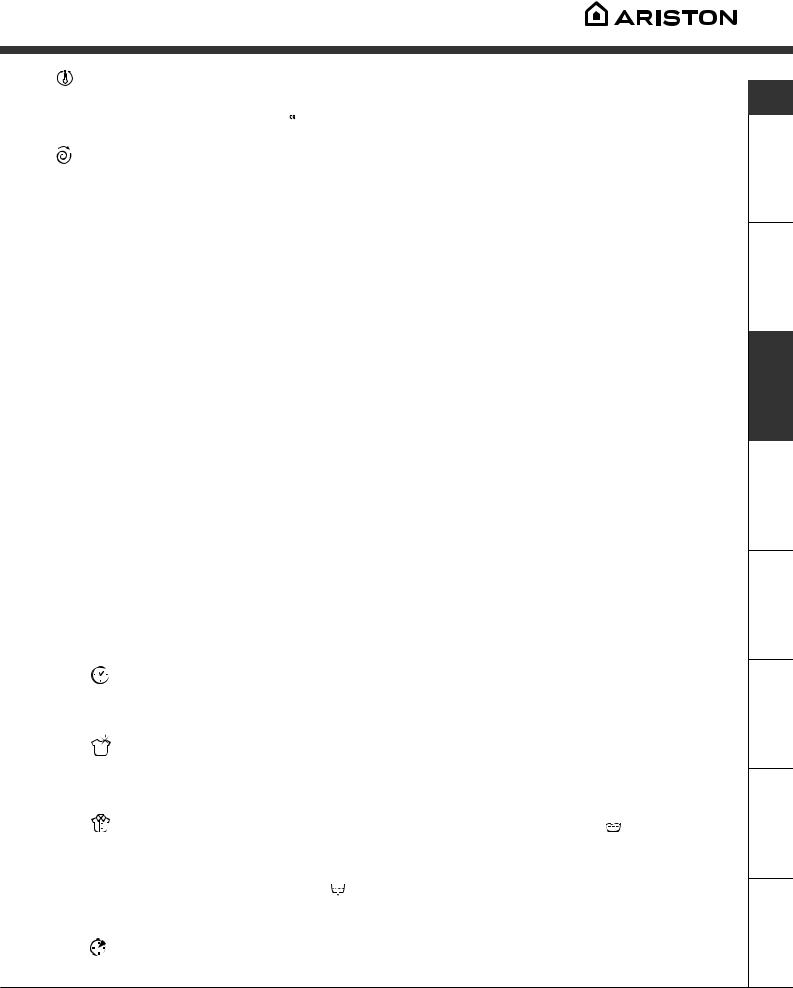
Individualisierungen
Einstellen der Temperatur
Durch Drehen des Wahlschalters TEMPERATUR wird die Waschtemperatur eingestellt. (siehe Programmtabelle auf Seite 18). Die Temperatur kann bis auf Kaltwäsche (
Einstellen der Schleuder
Durch Drehen des Wahlschalters SCHLEUDER wird die Schleudergeschwindigkeit des gewählten Waschprogramms eingestellt.
Folgende Höchstgeschwindigkeiten sind für die einzelnen Programme vorgesehen:
|
Waschprogramme |
Höchstgeschwindigkeit |
|
Baumwolle |
800 U/min |
|
Kunstfasern |
800 U/min |
|
Wolle |
600 U/min |
|
Seide |
no |
Die Schleudergeschwindigkeit kann herabgesetzt; durch Wahl des Symbols 
Der Waschvollautomat verhindert automatisch ein höheres Schleudern, falls die für das entsprechende Programm vorgeschriebene Schleuderdrehzahl überstiegen wird.
Funktionen
Die verschiedenen Waschfunktionen, die Ihnen Ihr Waschvollautomat bietet, ermöglichen es Ihnen, hygienisch saubere und weiße Wäsche zu erhalten, die Ihren Wünschen entsprechen. Aktivierung der Funktionen:
1.Die Taste der gewünschten Funktion gemäss untenstehender Tabelle drücken;
2.Das Einschalten bzw. Aufleuchten der entsprechenden Taste zeigt an, dass die Funktion aktiviert wurde.
Anmerkung: Sollte die Taste jedoch auf Blinklicht schalten, bedeutet dies, dass die Funktion zu dem eingestellten Programm nicht zugeschaltet werden kann.
|
Funktionen |
Wirkung |
Anleitungen zur Anwendung |
Aktiv mit |
||
|
den |
|||||
|
Programm- |
|||||
|
en: |
|||||
|
Delay |
Start kann bis zu |
Drücken Sie die Taste so oft, bis die Kontrollleuchte der |
Alle |
||
|
Timer |
9 Std. |
gewünschten Zeitverschiebung aufleuchtet. |
|||
|
(Start- |
verschoben |
Ein fünfter Tastendruck deaktiviert die Funktion. |
|||
|
vorwahl) |
werden. |
NB: Ist die Taste START/RESET einmal gedrückt, kann der |
|||
|
gewählte Zeitverschiebungswert nur noch herabgesetzt |
|||||
|
werden. |
|||||
|
Super |
Für einwandfrei |
Nicht mit der Funktion KURZ zu kombinieren. |
1, 2, 3, |
||
|
Wash |
saubere, sichtbar |
5, 6, 7, 8 |
|||
|
weißere Wäsche |
|||||
|
des Klasse A- |
|||||
|
Standards. |
|||||
|
Bügelleic- |
Reduziert die |
Wurde diese Funktion eingestellt, werden die Programme 6, |
Alle, mit |
||
|
ht |
Knitterbildung |
7, 8, 11 und Sanftes Spülen unterbrochen, das Wasser wird |
Ausnahme |
||
|
und erleichtert |
nicht abgepumpt, die Wäsche bleibt im Wasser liegen |
1, 2, 4, 9, |
|||
|
so das Bügeln. |
(Knitterschutz), und die Kontrollleuchte der Spülphase |
10, |
|||
|
schaltet auf Blinklicht: |
Abpumpen. |
||||
|
— um den Waschgang zu beenden, Taste START/SELECT |
|||||
|
drücken; |
|||||
|
— nur das Wasser abpumpen: Knopf auf das entsprechende |
|||||
|
Symbol |
drehen und die Taste START/RESET drücken. |
||||
|
Kurz |
Verkürzt die |
Nicht mit der Funktion SUPER WASH zu kombinieren. |
1, 2, 3, |
||
|
Dauer des |
5, 6, 7, 8 |
||||
|
Waschvorgangs |
|||||
|
um ca. 30%. |
|||||
DE
und Wartung
Kundendienst Störungen Pflege Vorsichtsmaßregeln Waschmittel Waschprogramme Beschreibung Installation
19
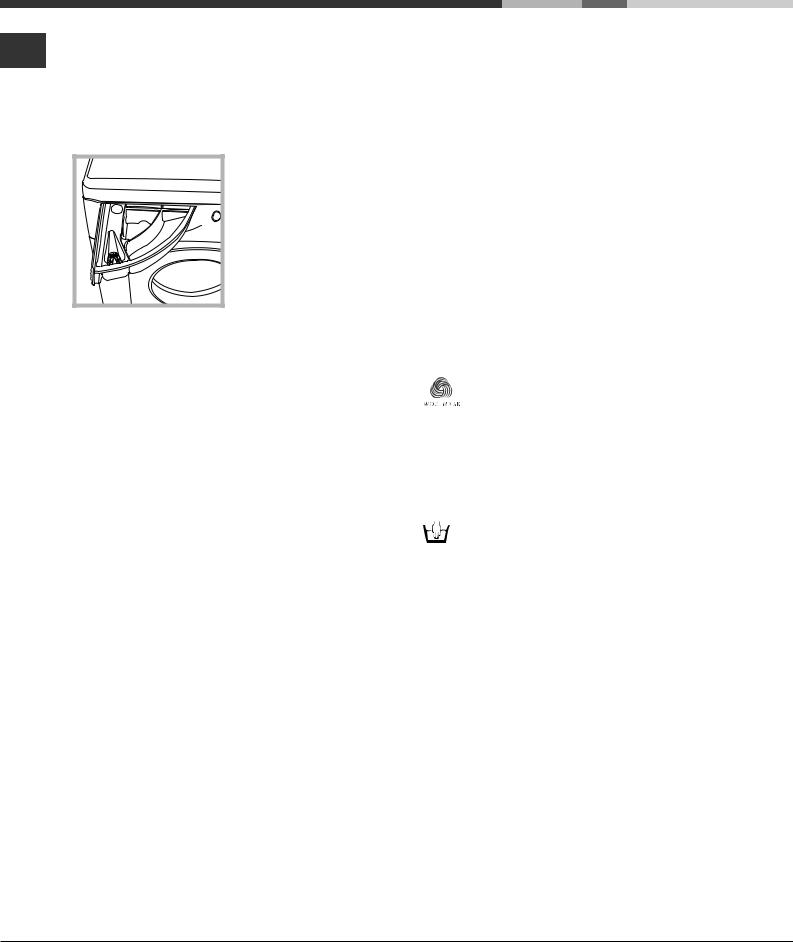
Waschmittel und Wäsche
Waschmittelschublade
DE
Ein gutes Waschergebnis hängt auch von einer korrekten Waschmitteldosierung ab: Eine zu hohe Dosierung bedeutet nicht unbedingt reinere Wäsche, sie trägt nur dazu bei, die Maschineninnenteile zu verkrusten und die Umwelt zu belasten.
Schublade herausziehen und Waschmittel oder Zusätze wie folgt einfüllen:
In Kammer 1: Waschpulver für die Vorwäsche (kein Flüssigwaschmittel)
In Kammer 2: Waschmittel für die Hauptwäsche (Waschpulver oder Flüssigwaschmittel)
Flüssigwaschmittel nur kurz vor dem Start einfüllen.
In Kammer 3: Zusätze (Weichspüler usw.)
Der Weichspüler darf das Gitter nicht übersteigen.
Verwenden Sie keine Handwaschmittel, sie verursachen eine zu hohe Schaumbildung.
Vorsortieren der Wäsche
•Sortieren Sie die Wäsche nach:
—Gewebeart / Waschetikettensymbol
—und Farben: Buntwäsche von Weißwäsche trennen.
•Entleeren Sie alle Taschen.
•Das angegebene Gewicht, das sich auf die maximale Ladung an Trockenwäsche bezieht, sollte nicht überschritten werden:
Widerstandsfähige Gewebe: max 5 kg Kunstfasergewebe: max 2,5 kg Feinwäsche: max 2 kg
Wolle: max 1 kg
Wie schwer ist Wäsche?
1Bettuch 400-500 gr
1Kissenbezug 150-200 gr
1Tischdecke 400-500 gr
1Bademantel 900-1.200 gr
1Handtuch 150-250 gr
Besondere Wäscheteile
Gardinen:Gardinen zusammengefaltet in einem Kissenbezug oder in einem netzartigen Beutel waschen. Waschen Sie diese allein, ohne das Gesamtgewicht für halbe Füllung zu übersteigen. Stellen Sie das Programm 11 ein, das ein automatisches Ausschließen der Schleuder vorsieht.
Skijacken und Anoraks: Sind diese mit Gänseoder Daunenfedern gefüttert, können sie im Waschvollautomaten gewaschen werden. Ziehen Sie die Teile auf links, achten Sie auf eine maximale Beladung von 2/3 kg, wiederholen Sie 2/3 Spülgänge und stellen Sie die Schleuder auf Schonschleudern ein.
Tennisschuhe: Entfernen Sie Schlammreste. Tennisschuhe können zusammen mit Jeans oder sonstigen widerstandsfähigen Teilen, nicht jedoch mit Weißwäsche, gewaschen werden.
Wolle: Verwenden Sie Spezialwaschmittel; Lademenge von 1 kg bitte nicht überziehen.
Cachemire Platinum
Schonend wie Waschen von Hand.
Ariston hat einen neuen Standard hochwertiger 
Verwenden Sie für alle mit «Handwäsche» ausgezeichneten Teile das Programm 10 und
Spezialwaschmittel.
20
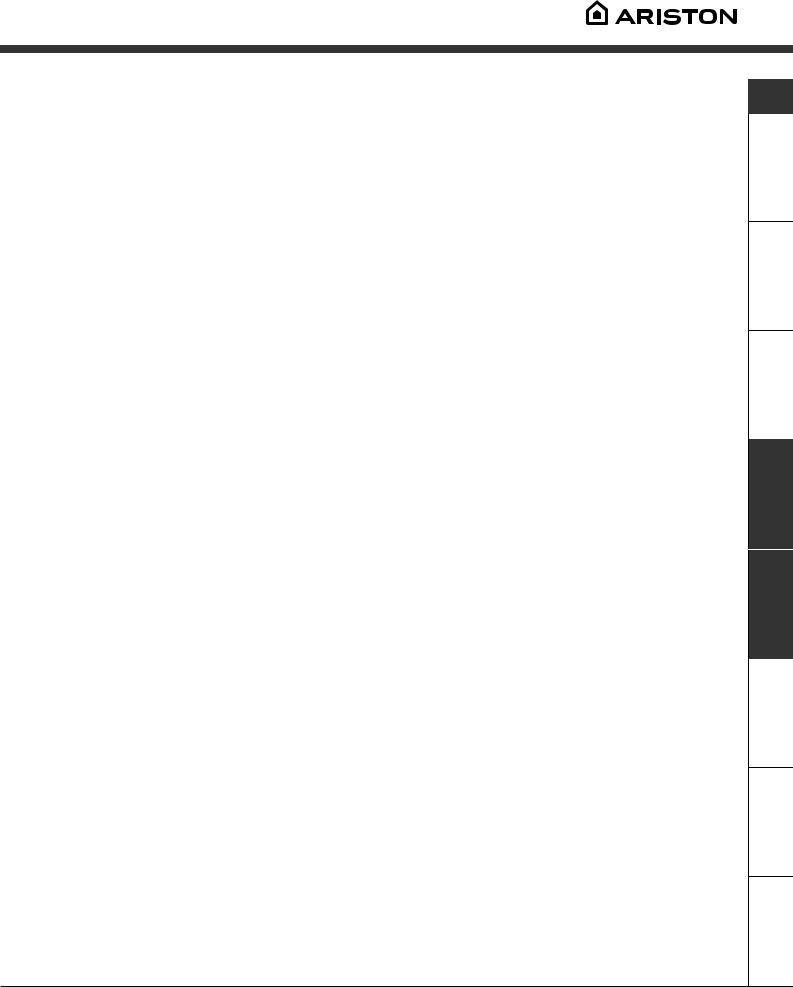
Vorsichtsmaßregeln und Hinweise
Der Waschvollautomat wurde nach den strengsten internationalen Sicherheitsvorschriften entworfen und gebaut. Nachstehende Hinweise werden aus Sicherheitsgründen geliefert und sollten aufmerksam gelesen werden.
Allgemeine Sicherheit
•Dieses Gerät wurde für den nicht professionellen Einsatz im privaten Haushalt konzipiert und seine Funktionen dürfen nicht verändert werden.
•Der Waschvollautomat darf nur von Erwachsenen und gemäß den Anleitungen dieses Handbuchs bedient werden.
•Berühren Sie das Gerät nicht, wenn Sie barfuß sind, und auch nicht mit nassen oder feuchten Händen oder Füßen.
•Ziehen Sie den Gerätestecker nicht am Kabel aus der Steckdose, sondern nur am Stecker selbst.
•Öffnen Sie die Waschmittelschublade nicht, wenn das Gerät in Betrieb ist.
•Berühren Sie nicht das Ablaufwasser, es kann sehr heiß sein.
•Öffnen Sie das Füllfenster nicht mit Gewalt: Der Sicherheits-Schließmechanismus könnte hierdurch beschädigt werden.
•Bei etwaigen Störungen versuchen Sie bitte nicht, Innenteile selbst zu reparieren.
•Halten Sie Kinder stets von dem in Betrieb befindlichen Gerät fern.
•Während des Waschgangs kann das Füllfenster sehr heiß werden.
•Muss der Waschvollautomat versetzt werden, sollten hierfür mindestens 2/3 Personen verfügbar sein. (Vorsichtig vorgehen). Versuchen Sie es niemals allein, das Gerät ist äußerst schwer.
•Vergewissern Sie sich, dass die Trommel völlig leer ist, bevor Sie die Wäsche einfüllen.
Entsorgung
• Entsorgung von Elektroaltgeräten
Gemäß der Europäischen Richtlinie 2002/96/EC über Elektround Elektronik-Altgeräte (WEEE) dürfen Elektrohaushalts-Altgeräte nicht über den herkömmlichen Haushaltsmüllkreislauf entsorgt werden. Altgeräte müssen separat gesammelt werden, um die Wiederverwertung und das Recycling der beinhalteten Materialien zu optimieren und die Einflüsse auf die Umwelt und die Gesundheit zu reduzieren. Das
Symbol „durchgestrichene Mülltonne“ auf jedem Produkt erinnert Sie an Ihre Verpflichtung, dass Elektrohaushaltsgeräte gesondert entsorgt werden müssen.
Endverbraucher können sich an Abfallämter der Gemeinden wenden, um mehr Informationen über die korrekte Entsorgung ihrer Elektrohaushaltsgeräte zu erhalten.
•Entsorgung des Altgerätes:
Machen Sie das Gerät vor der Entsorgung unbrauchbar. Schneiden Sie das Kabel ab und nehmen Sie das Füllfenster ab.
Energie sparen und Umwelt schonen
Technologie im Dienste der Umwelt
Glauben Sie, durch das Füllfenster hindurch wenig Wasser zu sehen? Dank der neuen Technik genügt die halbe Wassermenge für eine maximale Sauberkeit: eine Maßnahme die zum Schutze der Umwelt angestrebt wurde.
Waschmittel, Wasser, Energie und Zeit sparen
•Verschwendung von Strom, Wasser, Waschmittel und Zeit kann man vermeiden, indem man die Waschmaschine mit der empfohlenen Höchstwäschemenge benutzt. Bei einer vollen Auslastung Ihres Waschvollautomaten können Sie bis zu 50% Energie sparen.
•Vorwäsche ist nur bei stark verschmutzter Wäsche erforderlich. Durch Vermeidung einer solchen kann Waschmittel, Zeit, Wasser und 5-15% Energie gespart werden.
•Flecken sollten mit einem Fleckenmittel vorbehandelt werden, oder weichen Sie die Wäsche vor der Wäsche ein. Hierdurch können hohe Waschtemperaturen vermieden werden. Ein 60°C-Programm anstelle eines 90°C-Programms, oder ein 40°C-Programm anstelle eines 60°C-Programms hilft bis zu 50% Energie zu sparen.
•Dosieren Sie Waschmittel sparsam je nach Wasserhärte, Verschmutzungsgrad und Wäschemenge, um die Umwelt nicht über Gebühr zu belasten: obwohl sie biologisch abbaubar sind, beinhalten Sie dennoch Stoffe, die die Umwelt belasten. Auch Weichmacher sollten höchst sparsam eingesetzt werden.
•Waschen Sie am späten Nachmittag oder in den ersten Morgenstunden, hierdurch tragen sie dazu bei, die Belastung der Elektrizitätswerke zu mindern.
Die Option ‚Delay Timer’ (siehe Seite 31) hilft Ihnen in dieser Hinsicht außerordentlich.
•Soll die Wäsche in einem Wäschetrockner getrocknet werden, dann stellen Sie eine hohe Schleudergeschwindigkeit ein. Je trockener die Wäsche geschleudert wird, desto niedriger ist der zum Trocknen erforderliche Energieverbrauch.
DE
und Wartung
Kundendienst Störungen Pflege Vorsichtsmaßregeln Waschmittel Waschprogramme Beschreibung Installation
21
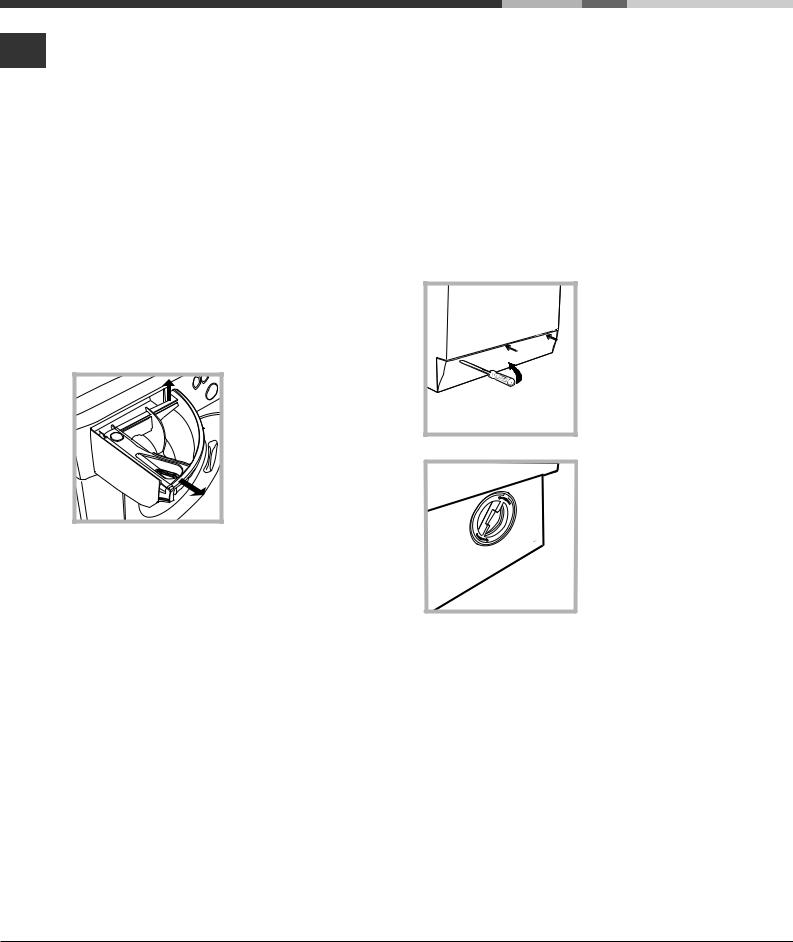
Reinigung und Pflege
Wasserund Stromversorgung abstellen
DE
•Wasserhahn nach jedem Waschvorgang zudrehen. Hierdurch wird der Verschleiß der Wasseranlage verringert und Wasserlecks vorgebeugt.
•Ziehen Sie den Stecker aus der Steckdose, bevor Sie Ihren Waschvollautomaten reinigen.
Reinigung der Pumpe
Ihr Gerät ist mit einer selbstreinigenden Pumpe ausgerüstet, eine Wartung ist demnach nicht erforderlich. Es könnte doch einmal vorkommen, dass kleine Gegenstände (Münzen, Knöpfe) in die zum Schutz der Pumpe dienende Vorkammer (befindlich unter der Pumpe) fallen. ! Vergewissern Sie sich, dass der Waschgang abgeschlossen ist und ziehen Sie den Stecker heraus.
Vergewissern Sie sich, dass der Waschgang abgeschlossen ist und ziehen Sie den Stecker heraus.
Reinigung des Gerätes
Die Gehäuseteile und die Teile aus Gummi können mit einem mit warmer Spülmittellauge angefeuchteten Tuch gereinigt werden. Vermeiden Sie Löseund Scheuermittel.
Reinigung der Waschmittelschublade
Heben Sie die Schublade leicht an und ziehen Sie sie nach vorne hin heraus (siehe Abbildung).
Spülen Sie diese regelmäßig unter fließendem Wasser gründlich aus.
Pflege der Gerätetür und Trommel
•Lassen Sie die Füllfenstertür stets leicht offen stehen, um die Bildung unangenehmer Gerüche zu vermeiden.
Zugang zur Vorkammer:
1. Die Abdeckung (befindlich an der Gerätefront) mit Hilfe eines Schraubenziehers abnehmen (siehe Abbildung);
2.den Deckel gegen den Uhrzeigersinn abdrehen (siehe Abbildung): es ist ganz normal, wenn etwas Wasser austritt;
3.das Innere gründlich reinigen;
4.den Deckel wieder aufschrauben;
5.die Abdeckung wieder anbringen. Stellen Sie hierbei sicher, dass die Haken in die Schlitze eingreifen, bevor Sie die Abdeckung fest andrücken.
Kontrolle des Wasserzulaufschlauchs
Kontrollieren Sie den Zulaufschlauch mindestens einmal im Jahr. Weist er Risse bzw. Brüche auf, muss er ausgetauscht werden. Der starke Druck während des Waschprogramms könnte zu plötzlichem Platzen führen.
Verwenden Sie niemals bereits gebrauchte Schläuche.
22

Model type:
AVL84EU
Commercial code:
29892
mod.AVL84EU page 2
General notes
Technical Documentation guidelines
———————————————————————————————————————————-
————————————————————-
You can find herewith some generic information to simplify cunsulting of technical documentation:
1. Models of same range share the same exploded views, which report the richest set of spare parts:generally, a model does not
necessarly have a related spare part for each particular shown on exploded views.
2. Some spare parts can not be represented directly on the exploded views (instruction booklets, specific kit, etc…). You can find
those codes in the spare parts list with the same reference of particular where spares are installed or with references 099, 999.
Instruction booklets, once managed, appear with 000 reference.
3. On the higher right site of each exploded view there is a serial number which indicates the beginning of the production of
certain range:some models might have more than an exploded view for a given category, each distinguished by a different serial
no.and linked to another spare parts list, In this case, serial no. is required to supply the right spare part code. Exploded view to be
considered is the one with a more recent serial no. but previous than the one of the model that needs assistance.
4.Exploded views might require further updates even after publishing. Addition of new spares will go on following the already
existing numeration references. Revision number of an exploded view is shown into last four digits of serial number into upper
right hand corner.
5.The spare parts list associated to an exploded view shows related codes of spares managed for a certain model; for each spare
part other informations are available:
REF: reference no of spare into a table; SUBSTITUTE: list of spare(s) which can replace a code but that keeps same functional
characteristics
INDUSTRIAL CODE: list of variables of a model (shown into model label) where such spare is used; NOTICE: code of
information(s) to refer to complete technical intervention, track for changes or to find correct spare part code.
6. Some notices, into a same section are generic therefore cannot be directly linked to a spare part. In order to assist a model in
the best way as possible, it is helpful to pay attention to all notices and constantly verify documentation updates
7.Technical documentation cover shows model name and its commercial codes
mod.AVL84EU page 3
1140960 Exploded views
mod.AVL84EU page 4
1140960 Spare parts list
Ref. Code С сер.№ По Substitute Description Notice Industrial
001 C00093722 1 x C00141139 основная электропроводка a
003 C00093718 электропроводка ml + ps
006 C00093720 проводка, станд. заземление
008 C00093726 электропроводка comunic. n1040331
012 C00093715 проводка mr 240000700d1
014 C00093713 электропроводка evl + evp
015 C00111227 проводка дисплея
mod.AVL84EU page 5
1230140 Exploded views
mod.AVL84EU page 6
1230140 Spare parts list
Ref. Code С сер.№ По Substitute Description Notice Industrial
000 C00098456 user instructions booklet
000 C00098457 user instructions booklet pl-cz-sk-
001 C00091882 палец шарнирный ящика
002 C00094053 1 x C00097400 плата индикатора evoii n1040331
003 C00091890 держатель потенциометра avd
004 C00094065 1 x C00118964 диск рукоятки таймера 91298920000
91298920050
004 C00116381 диск ручки таймера, шелкогр.
005 C00091873 1 x C00115953 рукоятка программирования в 91298920000
91298920050
005 C00115953 рукоятка программирования в
006 C00094021 1 x C00115954 рукоятка термостата b27 28 pr 91298920000
91298920050
006 C00094589 центр.регул.рукоятка+piast.ass.8 91298920000
91298920050
006 C00115954 ручка термостата pr28 pw
006 C00116351 ручка регулировки
007 C00094356 клавиши на силиконе вкл-выкл n1040331
008 C00094358 кнопочная панель, заделанная n1040331
009 C00094357 рассеиватель света 4l evo2 avl n1040331
010 C00098455 control panel & handle ‘avl84eu’ n1040331
011 C00092157 1 x C00115670 смотровое окно в комплекте n1040322 91298920000
1 x C00115678 n1040333 91298920050
n1040352
011 C00115670 1 x C00116553 смотровое окно в комплекте n1040352 91298920000
91298920050
011 C00116240 люк в сборе evoii pw wd
012 C00092158 1 x C00116576 набор для раскрытия смотр. 91298920000
91298920050
012 C00116576 комплект для открывания люка
013 C00064505 1 x C00110325 белый плинтус 91298920000
91298920050
013 C00116552 цоколь белый pw
014 C00087084 регулируемая опора m8 h = 2,3
015 C00046666 хомут сливного шланга
mod.AVL84EU page 7
1230140 Spare parts list
Ref. Code С сер.№ По Substitute Description Notice Industrial
015 C00083828 пружина опоры d =11 mm h =
016 C00064541 петля смотрового окна 180ш n1040352
016 C00115666 шарнир из сплава зама 150° n1040352
017 C00081698 1 x C00116998 панель задняя белая27 91298920000
91298920050
017 C00116998 rear cover — white(pw)
018 C00084817 заглушка для корпуса при
019 C00094777 1 x C00145769 kit lock tub l=105 evo2
020 C00041575 крючок самоклеящийся
021 C00097549 2 x C00115666 cabinet white27 5kg ariston evo2 n1040352 91298920000
1 x C00115676 91298920050
1 x C00116032
021 C00116032 1 x C00117001 cabinet white27 5kg ariston evoii n1040352 91298920000
91298920050
021 C00117001 cabinet white(pw) 5kg ariston
022 C00091867 1 x C00116550 бел. верхняя панель 595 x 522 91298920000
91298920050
022 C00116550 бел. верхняя панель (pw) 595 x
023 C00109854 проводка панели управления
024 C00109856 1 x C00143077 плата индикатора evoii ariston n1040375
024 C00141151 1 x C00143338 плата индикатора evoii ariston
025 C00110055 1 x C00116392 кнопки, заделанные силиконом,
026 C00110115 кнопки вкл-выкл/сброс белые 91298920000
91298920050
026 C00116359 комплект клавиш pw вкл-
027 C00111787 white27 control panel & handle 91298920000
91298920050
027 C00116971 white pw control panel & handle
099 C00046667 зажим для проводки
099 C00064550 держатель сливных шлангов
099 C00065871 заглушка упаковки
099 C00089419 заглушка для отверстий d.6,5
mod.AVL84EU page 8
1230220 Exploded views
mod.AVL84EU page 9
1230220 Spare parts list
Ref. Code С сер.№ По Substitute Description Notice Industrial
001 C00082318 упругий ремень 1195h8
002 C00064786 1 x C00143260 винт m8x23 torx tefl
003 C00064527 конич.ведомый шкив d=280mm
004 C00094710 противовес верхний vpl evo2 15
005 C00094741 1 x C00118612 крепеж.винт противовес/ванна
006 C00064515 зажимн.кольцо
007 C00094714 1 x C00109645 пружина бака vpl 5 кг n1040320
007 C00109645 пружина бака evoii wisl lipet n1040320
008 C00094782 пластмассовая ванна lvb evo2 n1040307
009 C00092155 пружин.задн.кольцо evoii
010 C00092156 кольцо переднее evo ii
011 C00092154 прокладка смотрового окна n1040333
012 C00094711 противовес передний vpl 9,4 кг
013 C00008612 tube clamp 34,6-36,4
014 C00092411 хомут для шланга со стороны
015 C00092174 труба ванна-насос oko evizzate e
017 C00055037 расширитель n1040373
017 C00118593 расширитель
018 C00065152 гайка romob m6x20x1,6
019 C00094712 1 x C00115753 амортизатор 100n vpl n1040373
019 C00118592 амортизатор 100n evoii
020 C00094908 трубный зажим со стороны
021 C00066183 сильфон загрузки
022 C00141042 амортизаторы 100n kit n1040373
mod.AVL84EU page 10
1230340 Exploded views
mod.AVL84EU page 11
1230340 Spare parts list
Ref. Code С сер.№ По Substitute Description Notice Industrial
001 C00091633 кабель питания 3×1 schuko
002 C00019902 опора спиральн. сливн. шланга
003 C00027466 спир.сливной шланг с коленом
005 C00095750 проводка панели управления n1040331
006 C00087067 1 x C00143095 переключатель bitron 16
007 C00085195 8-поз. потенциометр idc rast 2,5
008 C00096027 reading desk pr28 symbols
009 C00093813 держатель пластинки со
010 C00046154 голубая крышка одел.присадок
011 C00046148 вращ.ящик моющего средства
012 C00064529 воронка
013 C00064537 опора реле давления
014 C00094717 реле давления vpl block
015 C00092412 зажим для трубки реле давления
016 C00094746 трубка реле давления l=505 lvb
017 C00019755 устройство противоударное
018 C00092173 воздушный фильтр-ловушка
019 C00085194 микрозамедлитель idc 3 контакт.
020 C00094715 сопротивление 1700/230 vpl
021 C00083915 температурный зонд ntc elth tl
022 C00045023 рукоятка фильтра askoll/plaset
022 C00045025 прокладка фильтра askoll/plaset
022 C00045027 насосный фильтр askoll/plaset n1040381
022 C00141034 комплект фильтра поршн.
023 C00076510 1 x C00092264 самоочищ. насос с предкамерой n1040381
023 C00119307 насос сливной 220-240 в/50 гц
024 C00094744 крепеж.винт двигатель/ванна
025 C00092153 коллекторный
025 C00097255 щетка электродвигателя ceset
025 C00097257 коллекторный
026 C00098272 eeprom avl84eu evoii sw
028 C00091908 опора модуля st
028 C00091909 крышка держателя avd
029 C00091907 1 x C00143056 электр. модуль. no eeprom st
034 C00095669 серийный ключ evoii — lb2000 — n1040317
mod.AVL84EU page 12
1230340 Spare parts list
Ref. Code С сер.№ По Substitute Description Notice Industrial
035 C00092177 2 x C00064534 крышка воронки 1e 2u ev0 ii
1 x C00110333
1 x C00115914
036 C00093843 электроклапан ie2u 7 lt.rst 2,5
037 C00064534 прокладка воронки
038 C00005572 прокладка заливочного шланга
040 C00003070 залив.шланг 1500 mm
042 C00064946 опора электроклапана 1 ev
mod.AVL84EU page 13
Notices
n1040296: Список неисправностей EVOII и процедура их устранения.
————————————————————————————————————————————————————————————————
Если стиральная машина находится в состоянии неисправности, при выполнении автотестирования
ранее указанная неисправность выдается снова и
выводится на дисплей ключа автотестирования.
Тип неисправности может указываться различным образом:
— на моделях AVD код неисправности выводится непосредственно на дисплей
машины.
— на моделях AVL неисправность индицируется с помощью светодиодов.
Указание типа неисправности с помощью светодиодов
Когда машина находится в состоянии неисправности:
1. Дверца машины блокируется
2. Индикатор блокировки дверцы быстро мигает (с частотой не менее > 1 Гц)
3. Светодиоды на панели управления мигают, указывая на код неисправности в соответствии с таблицей (рис. 01).
Пример, показанный ниже на рис. 02 (для случая неисправности F03), иллюстрирует, какие
светодиоды мигают при наличии неисправности, которой присвоен код ошибки F03
Список ошибок, неисправностей и предупредительных сообщений
F01: Короткозамкнут тиристор управления двигателем
— Проверить отсутствие утечек воды, которая могла бы попасть на
разъем J9 и замкнуть соответствующие выводы
— Проверить клеммы двигателя (в результате воздействия
химических остатков производственного процесса возможно
короткое замыкание)
— Заменить плату
F02: Двигатель заблокирован, цепь тахогенератора разомкнута / короткозамкнута
— Проверить, не заблокирован ли двигатель
— Проверить надежность контактов разъема J9 на плате
— Проверить обмотку тахогенератора:
сопротивление между выводами 1 и 2 разъема J9 должно находиться
в пределах между 115 Ом и 170 Ом. В случае короткого замыкания или обрыва
В случае разомкнутой или короткозамкнутой цепи прозвонить выводы 1 и 2 на разъеме J9, соответствующие
тахогенератору. В случае
трехфазного двигателя убедиться в наличии цепи между выводами 6 и 7 разъема J9
.
— Заменить двигатель
— Заменить плату
mod.AVL84EU page 14
F03: Цепь датчика NTC стирки разомкнута / короткозамкнута, или залипло реле включения ТЭНа стирки
сигнал при наличии заполнения)
— Проверить надежность контактов разъема J8 на плате
— Проверить датчик NTC, замерив сопротивление между выводами 11 и 12 разъема J8:
при температуре окружающей среды 20°C оно должно быть равно примерно 20 кОм.
— В случае неверного значения прозвонить провода, соединяющие разъем J8 с датчиком NTC.
Замерить ту же величину на самом датчике NTС
— Заменить датчик NTC
— Заменить плату
F04: Одновременные сигналы опорожнения и переполнения (реле давления залипло в положение «опорожнение»).
В случае, если реле давления залипло в положение «опорожнение», стиральная машина будет заливать воду
до достижения переполнения. Сливной насос будет автоматически включен
контактом реле давления, соответствующим состоянию переполнения.
— Проверить надежность контактов разъема J3 на плате
— Проверить состояние реле давления, прозвонив на разъеме J3 выводы 2 и
4 (они должны прозваниваться только при пустом баке); выводы
2 и 3 (они должны прозваниваться только при наличии воды в баке) и
выводы 2 и 1 (они должны прозваниваться только, если количество воды
в баке превышает нормальный уровень и уровень воды выше середины дверцы).
— Проверить провода, соединяющие разъем J3 с реле давления
— Заменить реле давления
— Заменить плату.
F05: Реле давления не достигло состояния «опорожнение» или заблокирован сливной насос
— Проверить надежность контактов разъема J9 на плате,
убедившись, что между выводами 8 и 9 имеется напряжение 220 В
— Проверить, подается ли питание на насос
— Проверить фильтр насоса + слив
— Заменить насос
— Заменить плату
F06: Отсутствует на AVD и AVL
F07: Отсутствует потребление тока ТЭНом стирки ( неисправность
выдается только при реле давления в состоянии «опорожнение»)
— Проверить надежность контактов разъема J3 на плате
-Прозвонить на разъеме J3 выводы 5 и 6, соответствующие ТЭНу
стирки. ТЭН 1800 Вт 230 В обладает омическим сопротивлением 25 Ом.
— Проверить состояние реле давления, прозвонив выводы 2 и 3 на разъеме J3 («общий» и «заполнение»): цепи между
ними быть не должно.
-Проверить состояние реле давления, прозвонив на разъеме J3 выводы 2 и 4: между ними должна быть
цепь
— Заменить ТЭН
— Заменить реле давления
— Заменить плату
F08: Залипло реле включения ТЭНа стирки (сигнал при наличии опорожнения) или
реле давления залипло в положение «заполнения» (одновременные сигналы заполнения и опорожнения)
Проверить надежность контактов разъема J3 на плате
— Проверить состояние реле давления, прозвонив на разъеме J3 выводы 2 и
4 (они должны прозваниваться только при пустом баке), выводы
2 и 3 (они должны прозваниваться при наличии воды в баке) и
выводы 2 и 1 (они должны прозваниваться только в том случае, когда уровень воды
в баке превышает нормальный и вода стоит выше середины дверцы).
— Проверить провода, соединяющие разъем J3 с реле давления
mod.AVL84EU page 15
— Прозвонить на разъеме J3 выводы 5 и 6, соответствующие ТЭНу.
— Заменить реле давления
— Заменить плату
F09: Обнаружена ошибка программы (ЭСППЗУ не запрограммировано или неисправно)
— В случае, если речь идет об установленной на заводе-изготовителе плате с припаянным ЭСППЗУ, заменить плату и
ЭСППЗУ
— В случае, если речь идет о запасных плате и ЭСППЗУ, проверить правильность
установки ЭСППЗУ в колодку на плате
F10: Одновременное отсутствие сигналов опорожнения и заполнения
— Проверить надежность контактов разъема J3 на плате
— Проверить состояние реле давления, прозвонив на разъеме J3 выводы 2 и
4 (они должны прозваниваться только при пустом баке), выводы
2 и 3 (они должны прозваниваться при наличии воды в баке) и
выводы 2 и 1 (они должны прозваниваться только в том случае, когда уровень воды
в баке превышает нормальный и вода стоит выше середины дверцы).
— Проверить провода, соединяющие разъем J3 с реле давления
— Заменить реле давления
— Заменить плату
F11: Отсутствие сигнала обратной связи от насоса (обмотка двигателя сливного насоса оборвана или не
подсоединена)
Проверить надежность контактов разъема J9 на плате
— Замерить сопротивление между выводами 1 и 2 разъема J15 (в случае стиральной машины с системой блокировки
дверцы
Easy Door) или выводами 8 и 9 разъема J9 (в случае традиционной системы блокировки
дверцы); оно должно быть
равно 170 Ом.
-Проверить провода, соединяющие разъем J15 (или J9) с насосом
-Заменить насос.
— Заменить плату
F12: Отсутствие связи между платой дисплея и основной платой
— Проверить надежность контактов разъема J11 на плате
-Прозвонить провода, соединяющие разъем J11 с 5-контактным разъемом на плате дисплея
— Заменить основную плату.
— Заменить плату дисплея/светодиодов
F13: Цепь датчика NTC сушки разомкнута / Датчик NTC сушки отключен
Проверить надежность контактов разъема J10 на плате
Проверить датчик NTC, замерив на разъеме J10 сопротивление между выводами 7 и 8; при температуре окружающей
среды 20°C сопротивление датчика должно быть равным примерно 20 кОм
Прозвонить провода на разъемах J10 /NTC
Заменить датчик NTC
Заменить плату
F14: Цепь ТЭНа сушки разомкнута или датчик сушки не подключен
Проверить надежность контактов разъема J2 на плате
Замерить сопротивление между выводами 1 и 2 разъема J2 с: омическое сопротивление ТЭНа сушки мощностью 1300 Вт
номинальным напряжением 230 В должно составлять около 40 кОм
Проверить провода, соединяющие разъем J10/ТЭН сушки
Заменить ТЭН
Заменить плату
F15: ТЭН сушки постоянно включен (залипли контакты реле сушки или КЗ тиристора сушки)
Проверить надежность контактов разъема J2 на плате
mod.AVL84EU page 16
Проверить провода, соединяющие разъем J2/ТЭН сушки
Проверить провода, соединяющие разъем J3/реле давления
Заменить плату
F16: Блокировка барабана (только на машинах с верхней загрузкой)
F17: Цепь системы блокировки дверцы разомкнута или на нее не подается питание (с функцией Easy Door)
— Проверить на разъеме J4, вставленном в плату, наличие между выводами 3 и 4
напряжения сети 230 В (оно отсутствует, если машина находится
в режиме ожидания), а между выводами 3 и 5 (соответствующими выходу устройства блокировки дверцы) —
наличие напряжения 230 В
— Прозвонить на разъеме J4, вставленном в плату, выводы 1 и 2,
соответствующие микропереключателю дверцы (при раскрытой дверце цепи нет, при закрытой — есть)
— Прозвонить проводку между разъемом J4 и устройством блокировки дверцы
— Проверить защелку на дверце
— Заменить устройство блокировки дверцы
— Заменить плату
F17: Цепь системы блокировки дверцы разомкнута или на нее не подается питание (традиционная система блокировки
дверцы без функции Easy Door)
— Проверить на разъеме J4, вставленном в плату, наличие между выводами 2 и 3
напряжения сети 230 В (оно отсутствует, если машина находится
в режиме ожидания), а между выводами 3 и 1 (соответствующими выходу устройства блокировки дверцы) —
наличие напряжения 230 В
— Проверить защелку на дверце
— Заменить устройство блокировки дверцы
— Заменить плату
F18 —> Ошибка связи между микропроцессором и DSP (устройством цифровой обработки сигналов)
-Заменить плату
mod.AVL84EU page 17
mod.AVL84EU page 18
mod.AVL84EU page 19
n1040307: EVOII plastic bowls Brembate
————————————————————————————————————————————————————————————————
Only two bowl assemblies (without pulley) are managed as replacements for the EVOII range washing machines produced in the
Brembate factory:
095889 — BOWL 52 LITRES 6 KG 1200 RPM — SHAFT H=20mm;
mod.AVL84EU page 20
094782 — BOWL 46 LITRES 5 KG 1200 RPM — SHAFT H=20mm.
The above two bowls must be used when replacing the bowl, even on 800-1000 rpm appliances.
For intervention on 800-1000 rpm machines, also the pulley must be replaced with one of the same diameter but with a 20 mm
shaft insertion hole, as all 800-1000 rpm machines are fitted with pulleys with 17 mm shaft insertion hole.
PULLEY SPARE PART CODE:
064527 — pulley D=280mm H=17mm;
066080 — pulley D=210mm H=17mm;
097269 — pulley D=280mm H=20mm;
074211 — pulley D=210mm H=20mm.
n1040317: LB2000, EVOI, EVOII serial hardware key and relevant serial cable.
————————————————————————————————————————————————————————————————
The new serial hardware key Service code 095669, usable on all LB2000, EVOI and EVOII washing machines, can be connected
to the PC by means of F/M 9-pole cable Service code 099862 (see fig.001).
The previous F/F pin-to-pin 9-pole serial cable Service code 084943 can be used with the new key only if it is provided with the
M/M serial connector code 099861 (see fig. 002).
Cable code 084943 and serial key code 084566 will be available until stocks run out, after which they will be replaced by ESI
with Service codes 099862 and 095669 respectively.
mod.AVL84EU page 21
n1040320: Introduction of springs 109645 in place of 094714.
————————————————————————————————————————————————————————————————
From serial no. 40308.0001, all washing machines affected by this note have been equipped with springs Service code 109645 in
place of 094714.
mod.AVL84EU page 22
n1040331: Ariston LED restyling
————————————————————————————————————————————————————————————————
From serial no. 40429.0001, models AVSL85PL and AVSL85EU have been equipped with a new panel with well holes for the
ON/OFF and RESET buttons and flush plastic light diffusers in place of the projecting siliconed ones (see picture n10402231
Fig.02). These features determine whether an appliance is modified or premodification.
The modification has also involved the electronic card whose panel and display communication connectors are on the left and not
at the back (see picture n10402232 Fig.2).
The codes affected by this modification are:
For model AVSL85PL only
C00109966 — PANEL + HANDLE AVSL85PL LC
For model AVSL85EU only
C00109956 — PANEL + HANDLE AVSL85EU LC
For both models
C00109856 — LED CARD EVOII AVL /BUILT-IN ARISTON
C00110115 — WHITE BUTTONS ON-OFF/RESET EVOII LED KIT
C00109854 — PANEL WIRING LBE EVOII
C00110055 — SILICONED BUTTONS AVL-AVSL
C00110059 — PANEL WIRING -DISPLAY 240000848B2.
C00111227 — WIRING MAIN — DISPLAY 24000084804B1 (POLARIZED).
The new parts are only interchangeable with the pre-modification ones if used altogether. They are not individually
interchangeable.
This modification progressively involves all models of the Ariston Led range. The last two numbers of the Industrial Code for the
modified models is 50 (e.g. 80299050050).
n1040352: New 150° Zamac hinge on Ariston front-load 5 — 6 KG WMs (Brembate).
————————————————————————————————————————————————————————————————
From serial no. 50201.0001, all washing machines affected by this note have been equipped with the new hinges with 150°
opening rather than 180°.
The items affected by this modification are:
HINGE: new spare part code 115666, premodification spare part code 064541;
DOOR ASSEMBLY: new spare part code 115670, premodification spare part code 092157;
5 KG BODY: new spare part code 116032, premodification spare part code 097549;
6 KG BODY: new spare part code 116033, premodification spare part code 097709.
mod.AVL84EU page 23
n1040360: Polar White Factory 91 (Brembate)
————————————————————————————————————————————————————————————————
From serial no. 50404.0001, the new «Polar White» colour is used on all washing machines produced in factory 91 in place of
White 27.
The third last number of the Industrial Code given on the rating plate of the modified models is 9 (e.g. 91298310900).
To determine the new Polar White codes, it is necessary to know the industrial code or serial number of the appliance being
repaired.
The new items, which bear the initials «PW» in place of «B27», are not aesthetically interchangeable with premodification items
as the whites are different. Both colours will be available for some time.
n1040373: Modification of shock absorber and expander on LVB 5KG produced in Brembate.
————————————————————————————————————————————————————————————————
As from serial no. 50801.0001, new shock absorbers and expanders have been introduced.
New Part codes:
C00118592 — shock absorber
C00118593 — expander
Premodification Part codes:
C00115753 (EX C00094712) — shock absorber
C00055037 — expander
The new parts can be used (but not separately) also on all appliances equipped with shock absorbers 100N — C00115753 and
mod.AVL84EU page 24
C00094712; in this case, it will be necessary to replace both shock absorbers / expanders using kit C00141042, which is
composed of two new shock absorbers and two new expanders.
n1040375: New LED PCBs for washing machines.
————————————————————————————————————————————————————————————————
As from serial no. 50714.0001 new LED PCBs were introduced progressively.
New part codes:
C00141152 — INDESIT LED PCB (3 knobs)
C00141151 — ARISTON LED PCB
Premodification part codes:
C00111959 — INDESIT LED PCB (3 knobs)
C00109856 — ARISTON LED PCB
The new parts can be used on all appliances originally fitted with the premodification parts
and on all appliances affected by the modifications described in the Ariston ( n1040331 ) and Indesit ( n1040334 ) LED Restyling
information bulletins and having serial numbers next to the introduction serial number.
n1040381: Drain pump with bayonet-style filter — front Loading Brembate
————————————————————————————————————————————————————————————————
From serial no. 50720.0001 a new drain pump with bayonet-style filter has been installed on all front loading washing machines
manufactured in Brembate.
New parts:
C00119307 — Drain pump
C00141034 — Pump filter kit
Premodification parts:
C00092264 — Drain pump
C00045027 — Pump filter kit
The new parts can be used instead of premodification ones.
mod.AVL84EU page 25
mod.AVL84EU page 26
Electric schemes and links Cod. 16001668800
mod.AVL84EU page 27
Legend
Legend: 16001668800
AQS Aquastop electrovalve Mzbn/MTA zbn timer motor
B Buzzer N Neutral or Terminal Board
BC Blocco Cesto NC Spin cycle exclusion
BF Terminal board contact, motor fan and dryer P Pressure switch
BP Buzzer P1 1st level pressure cut-off switch
C Condensator P2 2nd level pressure cut-off switch
CA Condensator PA High speed potentiometer
DV Switching device PB Low speed potentiometer
EF/CL Electro-Valve Cold Water / Bleach PL Pure Wool
EF/L Electro-Valve Cold Water / Wash PM Motor Thermoprotector
EF/P Electro-Valve Cold Water / Prewash PR Timer programmer or Pressure switch
ER Exclude Heating Element PS Drain pump
ET Thermostat disactivation R Heating element
EV Electrovalve RE Relay
EVA Dryer electrovalve RR Heating element
EVC Hot water electrovalve RV Speed regulator
EVF Elettrovalvola acqua fredda Ras/RA Dryer heating element
EVL Wash electrovalve S LED
EVP Pre Wash electrovalve SL Line LED
FA Antijamming filter SO Door LED
FD Delicate drying cycle thermostat SR Heating LED
FE Strong drying cycle thermostat ST Temperature selector
FRT Thermofusible Heating Element SV Speed Selector for Spin
I Inverter T Timer contacts
I1..2..3.. Switches/switching devices TA Drying timer contacts
IA Switch On/Off TB Low Temperature Thermostat
IC Switch N.C. — 1/2 Load TC Spider wheel earth
ID Switch display TFL Flange earth
IE Water Saving Device TG Main earth
IF Switch — Spin Reduction TH Thermostat
IP Door switch TH1 1st temperature thermostat
IR Line switch TH2 2nd temperature thermostat
IS Water-stop TH3 3rd temperature thermostat
mod.AVL84EU page 28
L Line or Lamp THF Operating thermostat
LB Low Level THR Adjustable thermostat
LN Normal Level TM Motor earth
LS Pilot lamp TMB Main cabinet earth
M Earth-symbol TMP Motor thermal protector
MC Spin cycle motor TMS Thermostop
MI MOTOR WITH PULLEY TP Thermal protector
ML Wash cycle motor TPS Drain pump earth
MO Terminal Board TR Heating element earth
MP Door dip-switch TS Safety thermostat
MR Thermal Lock TT Timer earthing connection
MT Timer motor TTH Earthing Thermostat
MV Motor fan TV Tank earth
MV -Ras Dryer heating element ZBN Timer
mod.AVL84EU page 29
Electric schemes and links Cod. 21500759100
mod.AVL84EU page 30
Legend
Legend: 21500759100
Инструкция стиральной машины Ariston AVL 84
Хотим предложить бесплатно руководство пользователя стиральной машины Ariston AVL 84. Прочитав данную инструкцию по эксплуатации Вы сможете правильно работать с техникой.
Для просмотра содержания инструкции Вам понадобится программа Adobe Reader или DjVu.
Если на Вашем компьютере они не установлены, то Adobe Reader можно скачать с сайта Adobe, а DjVu с сайта DjVu
Смотрите также другие инструкции Ariston
- Ariston AVD 109
- Ariston ADS 1200
- Ariston AVSL 1090
- Ariston ALD 128 D
- Ariston TX60
- Ariston AVL 105
- Ariston AL 109 X
- Ariston AVTL 82
- Ariston AMD 129
Смотрите также другие инструкции раздела Стиральные машины
- LG F1294ND5
- Electrolux EWF 86110 W
- Whirlpool AWM 8000(Таблица программ)
- Bosch WAE 2448SOE
- Miele W 452 WPS Softtronic
- Gorenje WA942
- Indesit IWSD 5125 SL
- Zanussi ZWF 1026
- Candy Alise CMD 126
Download
Add to my manuals
Share
URL of this page:
HTML Link:
Bookmark this page
Manual will be automatically added to «My Manuals»
Print this page
- Manuals
- Brands
- Ariston Manuals
- Washer
- AVTL 84
- Instructions for installation and use manual
Hide thumbs
1
2
3
4
5
6
7
8
9
10
11
12
-
page
of
12/
12 -
Bookmarks
Advertisement
Quick Links
Download this manual
Previous Page
Next Page
- 1
- 2
- 3
- 4
- 5
Advertisement
Related Manuals for Ariston AVTL 84
-
Washer Ariston AVTL 104 Instructions For Use Manual
(72 pages)
-
Washer Ariston AVTL 60 Instructions For Use Manual
(12 pages)
-
Washer Ariston AVTF 129 Instructions For Use Manual
(72 pages)
-
Washer Ariston AVTL 89 Instructions For Use Manual
(12 pages)
-
Washer Ariston AVTF 109 Инструкция Для Использовальния
Washing machine (72 pages)
-
Washer Ariston AVTF 109 Instructions For Use Manual
(72 pages)
-
Washer Ariston AVTL104 Instructions For Use Manual
(72 pages)
-
Washer Ariston AVTL 83 Instructions For Use Manual
(60 pages)
-
Washer Ariston AVXXL149 Instruction Booklet
(12 pages)
-
Washer Ariston AVXXL149 Instruction Booklet
Washing machine (12 pages)
-
Washer Ariston AVXXF129 Instruction Booklet
Ariston instruction manual washing machine avxxf149, avxxf137, avxxf129 (12 pages)
-
Washer Ariston AVL 129 Instructions For Use Manual
Ariston washing machine instruction manual avl 129 (72 pages)
-
Washer ariston AVL 129 Instructions For Use Manual
(72 pages)
-
Washer Ariston AVSD 109 Instructions For Use Manual
Ariston washing machine instruction manual (84 pages)
-
Washer Ariston AVSD 109 Instructions For Use Manual
(84 pages)
-
Washer Ariston AVSD 109 Instructions For Use Manual
(84 pages)
Summary of Contents for Ariston AVTL 84
-
Page 4
LEDs Detergent dispenser LEDs… -
Page 10
Fig. 1 Fig. 2 Fig. 3 Fig. 4…





































